Mexico
Country Overview
Mexico is Latin America’s most accessible country in which to do business. Its extensive network of free trade agreements makes Mexico a good springboard to markets in the region.
With a population of 127 million and a flourishing middle class, Mexico is an attractive open economy. Its macro-economic stability, low inflation and steady economic growth create a relatively low-risk market for ongoing export activity. However, Mexico does have a large informal economy that impacts most sectors.
Mexico is ranked as the easiest place in Latin America to do business. It is New Zealand’s 24th largest export market, with dairy products and albuminoidal substances our top exports.
Mexico has a young population, a declining birth rate and a rise in childless households. There is a distinct economic divide between Mexico’s wealthy urban population and its poorer rural inhabitants. The wealthiest 20% of Mexicans earn 20 times more than the poorest 20%.
Trade agreements
Mexico has free trade agreements with 46 counties, including members of the Comprehensive and Progressive Agreement for Trans-Pacific Partnership (CPTPP). New Zealand is a member of the CPTPP, alongside Mexico, Malaysia, Singapore, Peru, Chile, Canada, Japan, Australia, Brunei Darussalam and Viet Nam. This has opened doors for trade opportunities with Mexico.
Country intelligence
The Robinson Country Intelligence Index is a holistic measurement of country-level risk and serves as an alternative measure of country development. It incorporates four broad dimensions of Governance, Economics, Operations and Society. A higher ranking indicates a better Country Intelligence Index score.

Value of New Zealand exports

International logistics performance
The International Logistics Performance Index measures how efficiently countries move goods across and within borders. Countries are ranked on their index score with a higher ranking indicating higher performance of trade logistics based on six components: customs, infrastructure, ease of international shipments, logistics services quality and competence, tracking and tracing, and timeliness.

Income and distribution of wealth
Global National Income (GNI) per capita is the dollar value of a country's final income in a year, divided by its population.
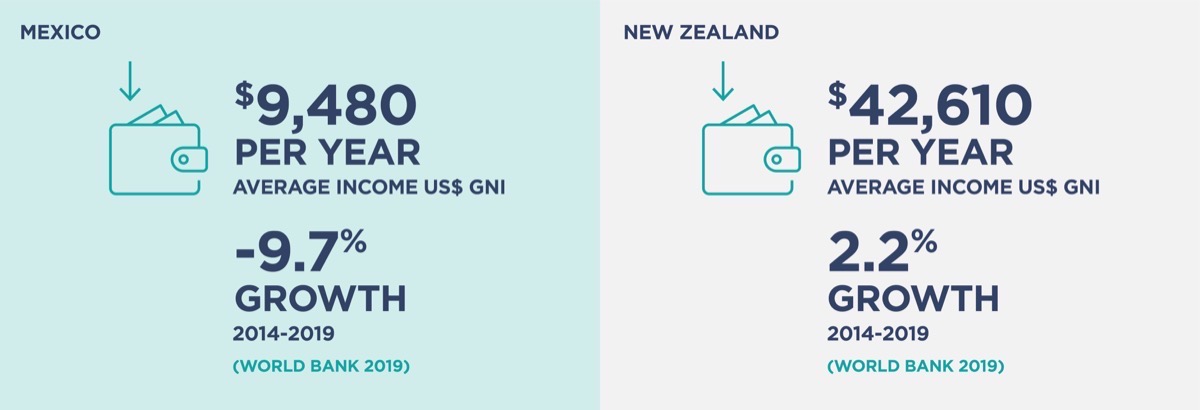
Annual Disposable Income refers to gross income minus social security contributions and income taxes. Each income band presents data referring to the percentage of households with a disposable income over that amount.
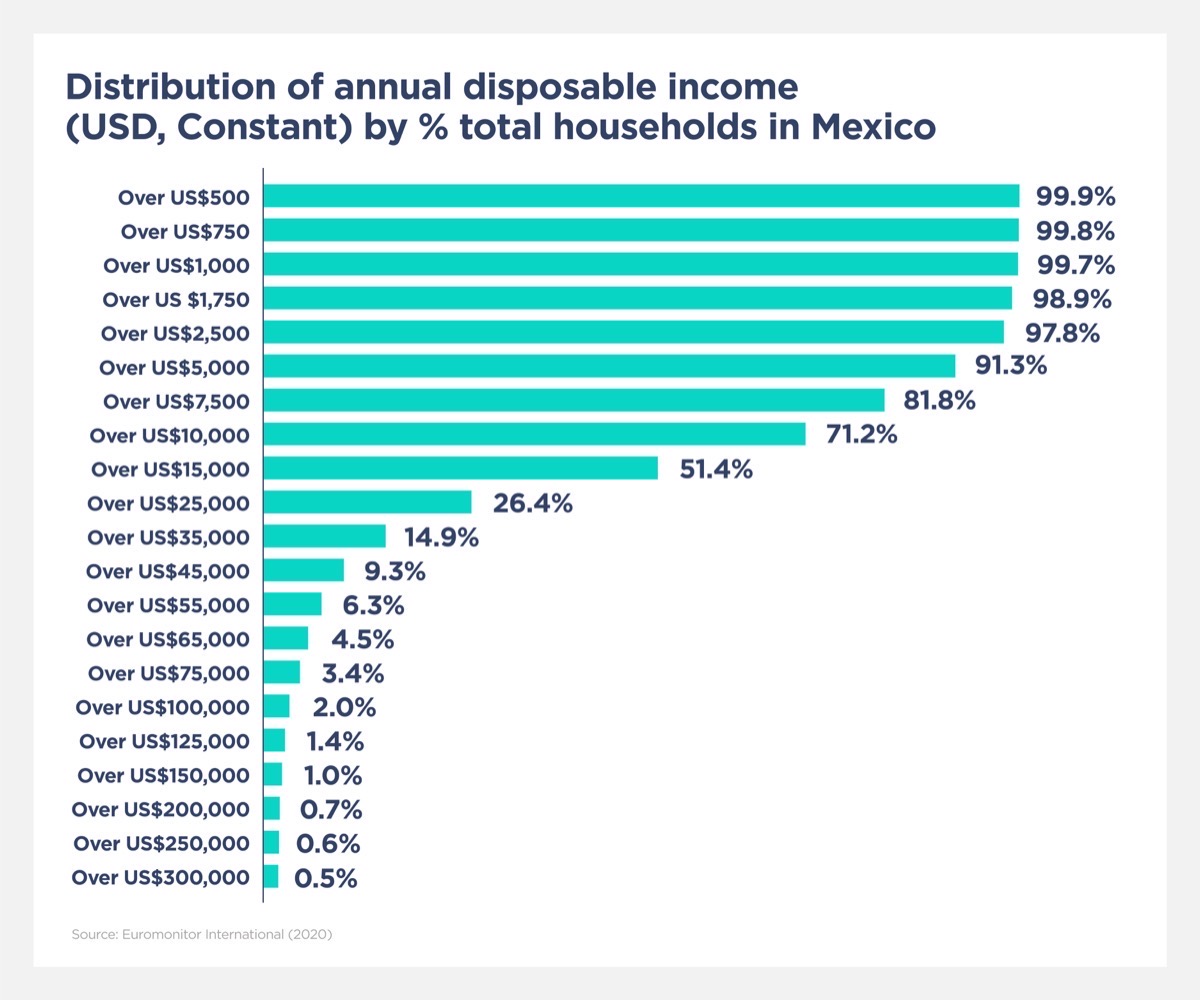
Further information
For more information to validate Mexico as an export market, see our Mexico Market Guide.
- Vitamins & Dietary Supplements
- Skin Care
- Dog & Cat Food
- Alcoholic Drinks
- Health & Wellness Packaged Food & Beverages
Vitamins & Dietary Supplements
- Market size and growth
-
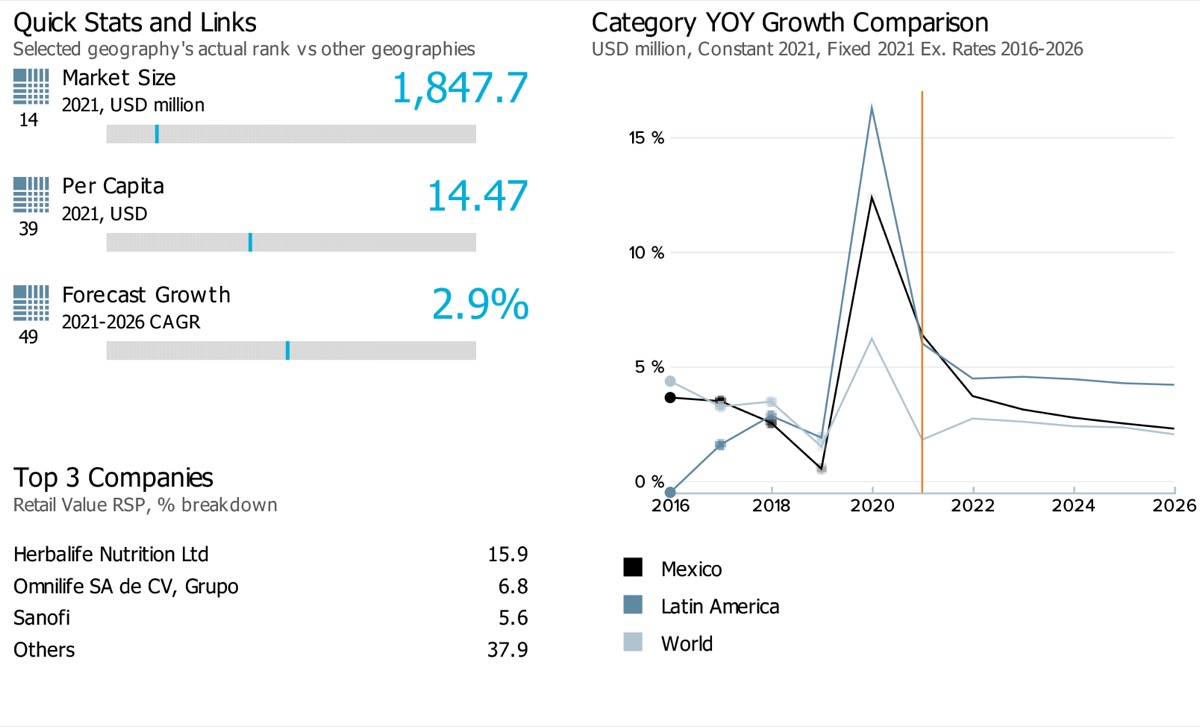
Note: Data on the top left corner of the image (14, 39, and 49) showcases respective ranks for Mexico for its market size, per capita, and forecast growth rate compared against 99 countries globally. The blue line on the grey bar represents the relative position of the country as per their rank.
Note: Latest market size data for the year 2021 has been shared for Vitamins & Dietary Supplements
In Mexico, retail value sales of vitamins and dietary supplements witnessed a historic compound annual growth rate (CAGR) of 9.5% during 2016-2021. It is further expected to see a slowed down retail value CAGR of 2.9% over 2021-2026. The expected slowdown is mainly in line with the global performance of the category, where it witnessed a historic CAGR of 5.1% and an estimated slowdown for the forecast CAGR (2.4%) over the same period for its retail value sales.
- Sub-category breakdown
-
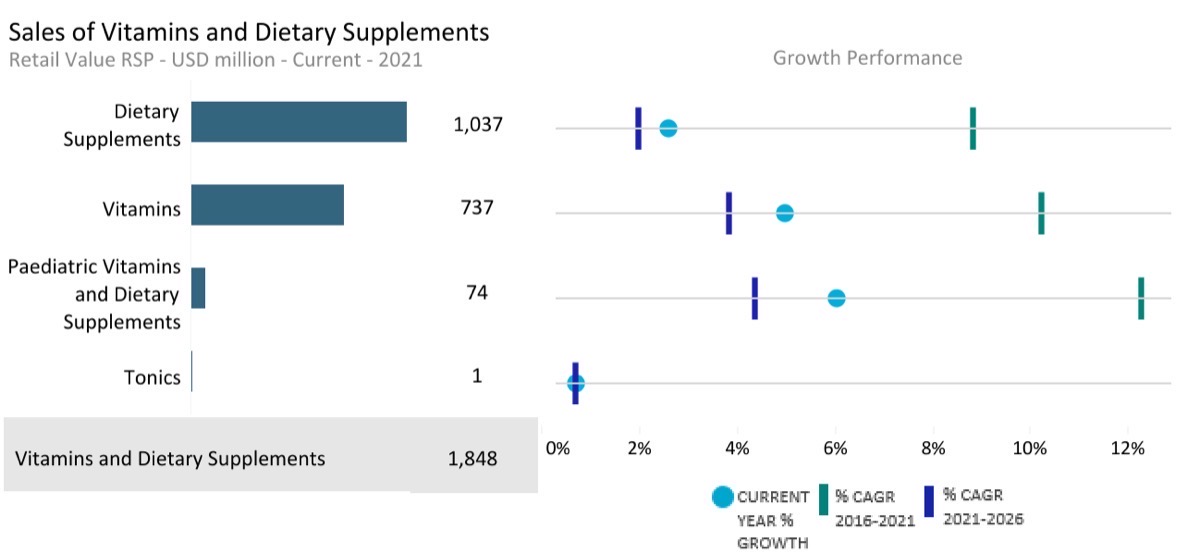
Note: Current year growth in the above chart refers to the period 2021-22
Category
Unit
Market size (2021)
Retail value RSP
Forecast compound annual growth rate (2021/2026) %
Vitamins and Dietary Supplements
USD million
1,847.65
2.85
Vitamins
USD million
736.59
3.85
Paediatric Vitamins and Dietary Supplements
USD million
73.70
4.38
Dietary Supplements
USD million
1,036.79
2.00
Tonics
USD million
0.57
0.71
- Channel distribution
-
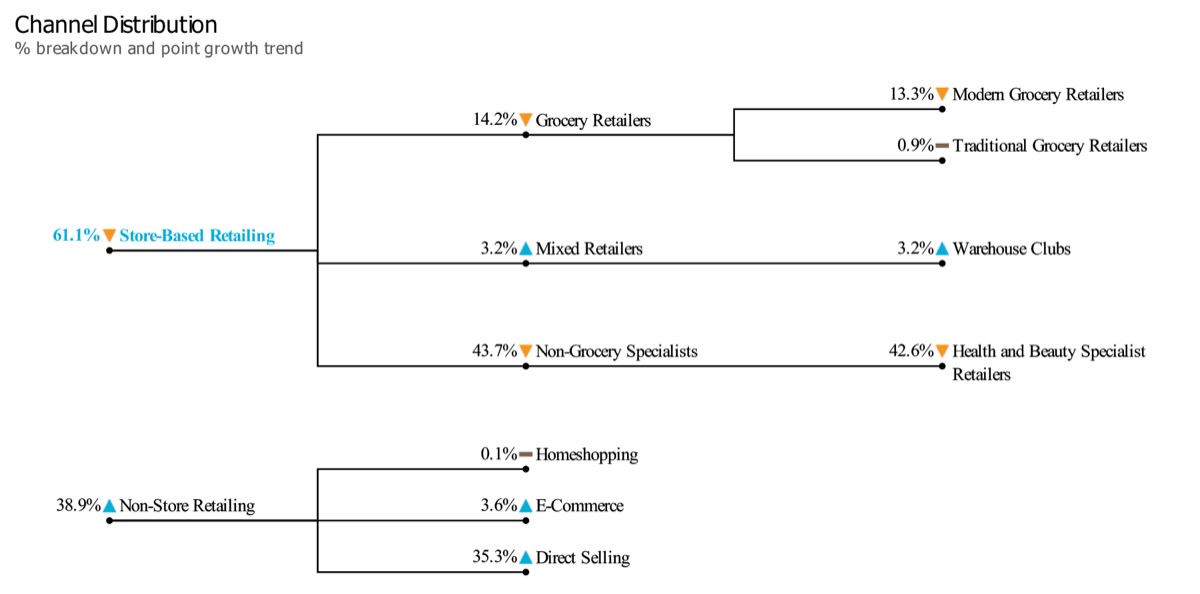
Note: The chart here showcases the retail value share of different channel sales for Vitamins and dietary supplement products in Mexico in 2021. The triangle/dash represents whether the specific channel share has increased/decreased or remained the same against its share in the previous year.
- Market Insights
-
Market trends
- In 2020, vitamins saw an enormous increase in its retail volume and value growth rates due to COVID-19. The spike in sales of vitamins is associated with the desire to strengthen both the respiratory and immune systems to help combat the virus. Consumers mainly rushed out to purchase vitamin C in the first half of the year.Multivitamins such as Aderogyl (vitamin C combined with other vitamins) which has a flu prevention positioning, also contributed to growth.
- Like vitamins, dietary supplements also experienced a substantial increase in their value growth rate in 2020, although not to such a dynamic extent as vitamins. Similarly, this is also associated with consumers’ desire to strengthen their immune system, especially their children’s, causing a rise in demand for paediatric dietary supplements. Therefore, in 2020 brands emphasised how their products could strengthen the immune system, including highlighting ingredients traditionally associated with other functions. For example, an advertisement for Omnilife promoted that magnesium can enhance the immune support function, whereas it is usually known for turning food into energy in the body.
Prospects and growth opportunity
- After the peak in demand in 2020 and 2021, consumption of dietary supplements will likely return to previous levels of growth in 2022. This assumes that the highest spike of COVID-19 has been overcome and that health will not be so prominent in consumers’ minds. Combination non-herbal/traditional dietary supplements are expected to witness strong demand and remain the largest category as consumers seek convenience and products that will meet various needs. However, many consumers will also continue to place an important role on specific single-ingredient supplements consumption, with information about the benefits of certain foods easily accessible. Cranberry, fish oil/omega fatty acids, and glucosamine are among the single ingredients with higher anticipated growth since consumers are already more knowledgeable of their benefits. This includes the antioxidants in cranberry and the omega-3 in fish oil/omega fatty acids.
- As for demand for vitamins, growth is expected to gradually decelerate over the rest of the forecast period (2021-2026). Nevertheless, growth will remain positive as there are likely to be long-term changes in consumers’ desire to strengthen their immune and respiratory systems and their general health. Vitamin C is expected to continue to drive value growth in the forecast period to 2026, followed by the largest category, multivitamins.
General health & wellness trends
- As is the case with packaged food, consumers in Mexico are showing a growing interest in dietary supplements made with natural and organic ingredients. Products that make organic claims or have official organic certifications have become more widely available in the country in recent years, including brands such as Orgain Organic Protein and OS Organic Side Organic Spirulina. The growing demand for such products is also expected to be supported by their improved distribution network. However, their high price point will remain a challenge as the economic difficulties due to the pandemic are likely to linger amongst Mexicans and prevent greater interest in organic products.
Skin Care
- Market size and growth
-
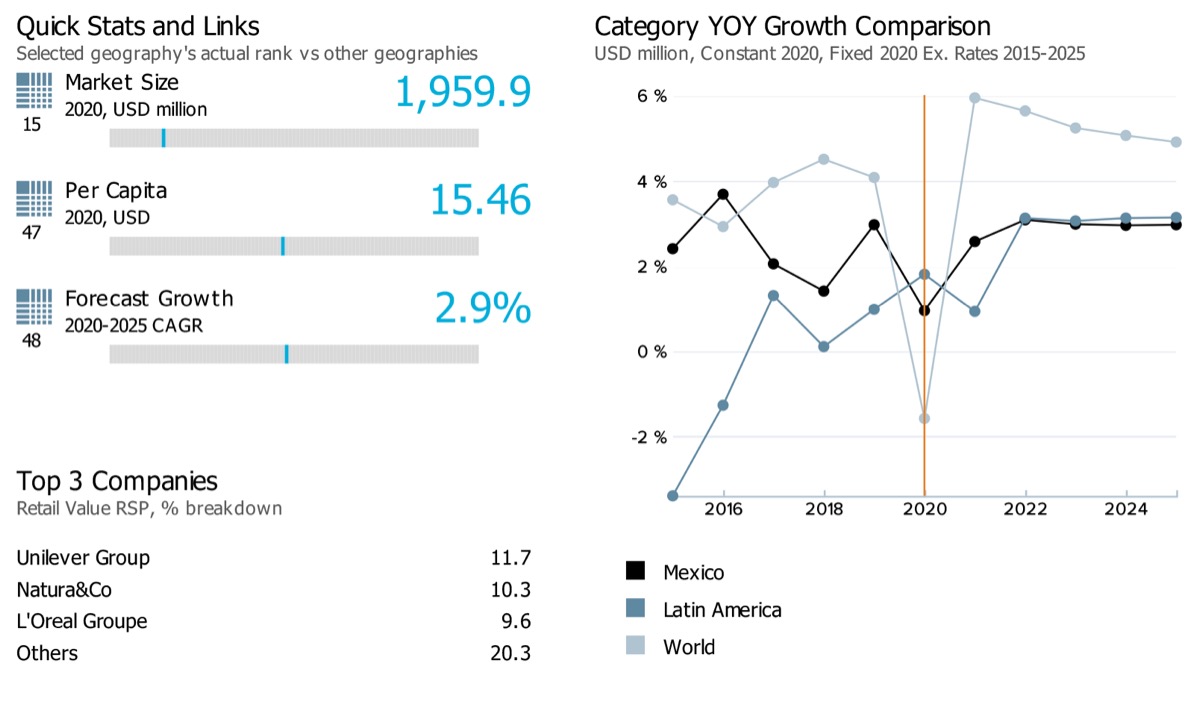
Note: Data on the top left corner of the image (15, 47, and 48) showcases respective ranks for Mexico for its market size, per capita, and forecast growth rate compared against 99 countries globally. The blue line on the grey bar represents the relative position of the country as per their rank.
Retail value sales of skin care products in Mexico witnessed a stronger compound annual growth rate (CAGR) during 2015-2020 (6.4%) against the category’s performance at a global level (4.7%) during the same period. However, over the forecast period (2020-2025), the category is estimated to witness an increased CAGR of 5.3% at the global level, while in Mexico, the category’s CAGR for the same period is estimated to slow down further and reach 2.9%.
- Sub-category breakdown
-
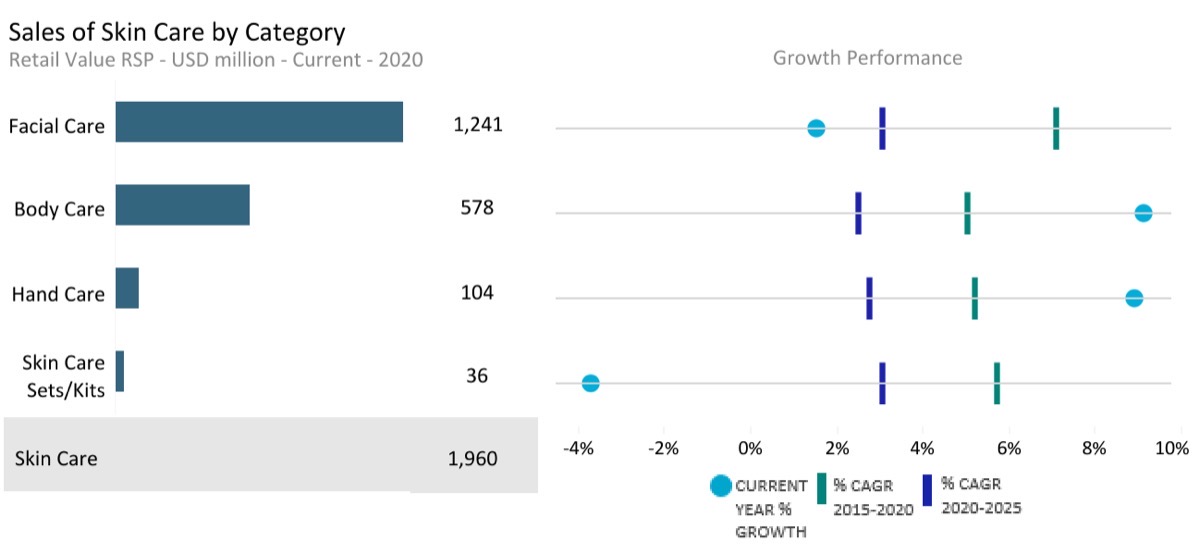
Note: Current year growth in the above chart refers to the period 2019-20
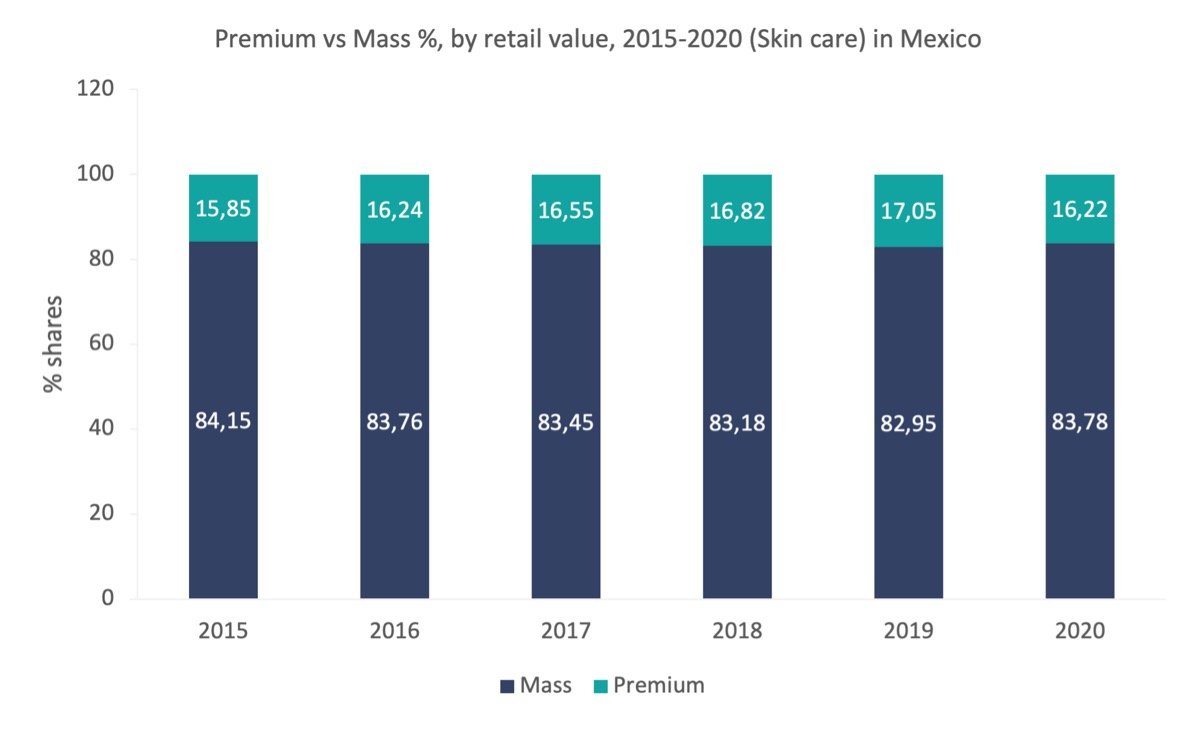
Category
Unit
Market size (2020)
Retail value RSP
Forecast compound annual growth rate (2020/2025) %
Skin Care
USD million
1,959.87
2.90
Body Care
USD million
578.34
2.50
Facial Care
USD million
1,241.43
3.09
Hand Care
USD million
103.62
2.78
Skin Care Sets/Kits
USD million
36.49
3.06
- Channel distribution
-
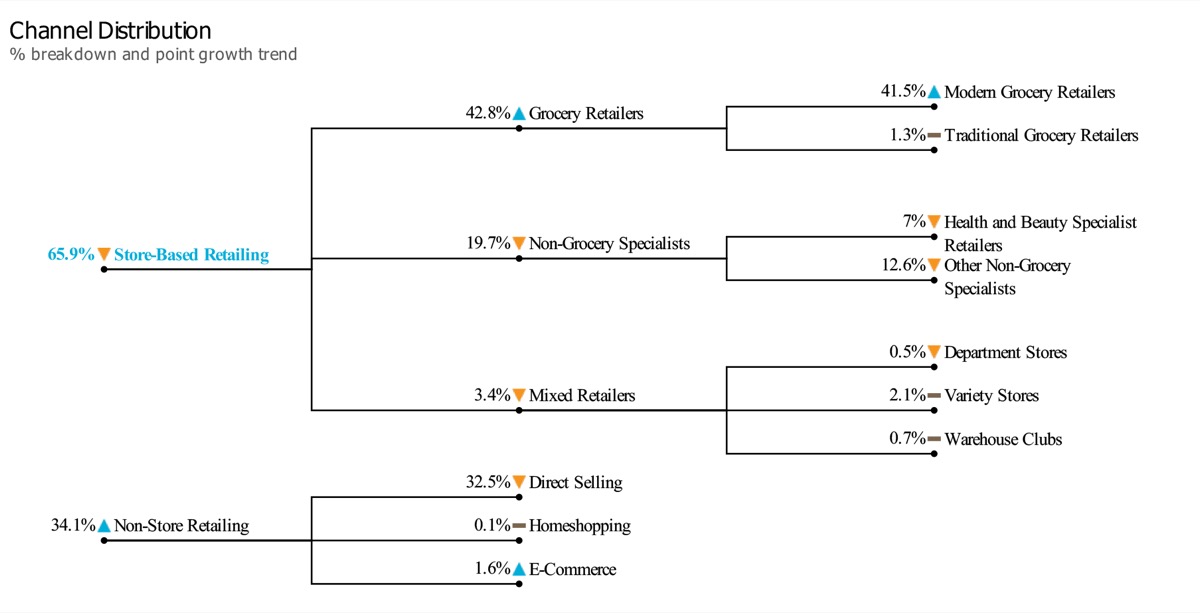
Note: The chart here showcases the retail value share of different channel sales for skin care products in Mexico in 2020. The triangle/dash represents whether the specific channel share has increased/decreased or remained the same against its share in the previous year.
- Market Insights
-
Market trends
- Skin care showed resilience in the face of the Coronavirus (COVID-19) crisis in Mexico. The demand for skin care products remained robust, supported by heightened hygiene concerns. For example, hand care products were demanded as the government and health authorities’ advised people to wash hands regularly to minimise the risk of infection. Similarly, consumers tried to ensure face and body hygiene with regular washing and showering. Continuous or more regular washing can result in dry or other skin issues, thereby necessitating the use of hand, body and/or facial care products. Many consumers also focused on antibacterial hand care and other skin care products, which were promoted as offering stronger resistance against the virus. In this vein, Jade, a direct selling brand, saw the launch of an antibacterial hand moisturiser to capture this demand.
- Facial care witnessed mixed results in 2020. Acne treatments posted retail volume and value growth because the heavy use of face masks resulted in “maskne”, which required treatment. However, facial cleansers, including make-up removers, saw a strong decline in retail volume sales and flat value sales, due to the reduced use of colour cosmetics due to home working and fewer social opportunities. Basic moisturisers and anti-agers also saw decreases in retail volume sales, as heightened economic concerns led some consumers to trade down to more affordable brands or more basic routines. However, the drop in demand for co-essential moisturisers and anti-agers was marginal and slight, respectively, as consumers continued to associate skin care with good health.
Prospects and growth opportunity
- Since the pandemic is not expected to be under control in the short term, the demand of specific skin care products is set to prove robust. Product types required to treat dry or other skin issues due to frequent hand/body/face washing will continue to see sales opportunities within body care, hand care and facial care. In addition, the ongoing use of face masks should continue to support sales of acne treatments in the short term. Consumers are increasingly interested in preventing rather than waiting to treat skin care problems once they appear. Therefore, facial masks and facial cleansers with claims like rejuvenating, detoxifying or hydrating, amongst others, are expected to enjoy good sales growth through the forecast period (2020-2025).
- Once the country emerges out of the pandemic and the economy recovers, the shift towards premium brands seen earlier in the review period is likely to be renewed, albeit slowly. While many consumers remain price-sensitive, primarily if they use higher quantities of products, the return to the workplace and socialising and steady recovery of consumer disposable incomes and expenditure should see more consumers look for higher-quality products. Premiumisation is also expected to be visible in terms of both packaging and quality of products, with companies responding to the growing call for more sustainable products. As skin care packaging sees further innovation towards sustainability, Belcorp México’s Esika pouches, which are claimed to contain 81% less plastic than regular packaging, and Estée Lauder Cosméticos’s packaging for Clinique, which is claimed to be manufactured with recycled glass, offer examples to follow and highlights areas of growth opportunities.
General health & wellness trends
- Products with micellar water are predicted to stimulate sales growth in facial care in short to medium term. This is especially likely as consumers return to the workplace and resume social interaction, thereby encouraging an upturn in the use of colour cosmetics, especially make-up items. While the pandemic has interrupted the move towards a newer perception of beauty in Mexico, micellar water is set to play a role in its revival in the forecast period to 2025. More and more women see healthy and nourished skin as a sign of beauty; therefore, they seek milder colour cosmetics and facial care products. This trend is expected to benefit moisturisers and treatments and facial cleansers, both mass and premium brands.
- Overall, as the economy improves and the threat of the virus recedes, the beauty and personal care industry, in general, is expected to benefit and grow in Mexico over the forecast period. Leading players are expected to increase consumer awareness of sustainability issues (product and packaging) and the demand for milder, more natural or added-value products. These factors are predicted to see premium brands renew their upward mobility in most categories while creating further growth opportunities for dermatological, although most consumers are likely to remain price-sensitive and favour mass products.
Dog & Cat Food
- Market size and growth
-
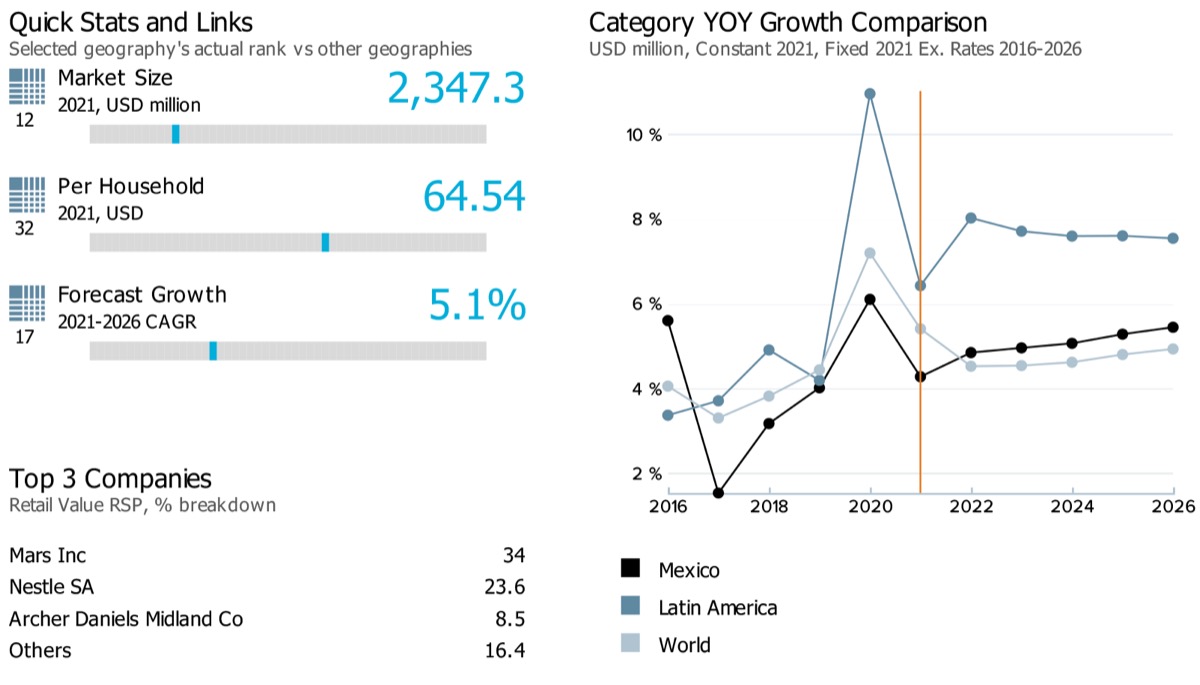
Note: Data on the top left corner of the image (12, 32, and 17) showcases respective ranks for Mexico for its market size, per capita, and forecast growth rate compared against 53 countries globally. The blue line on the grey bar represents the relative position of the country as per their rank.
Note: Latest market size data for the year 2021 has been shared for Dog and Cat food
Performance of retail value sales of dog and cat food in Mexico is estimated to slow down from a historic compound annual growth rate (CAGR) of 8.2% during 2016-2021 to an estimated forecast CAGR of 5.1% over 2021-2026. The category’s performance in the country has been slightly stronger than its global performance. Globally, the category witnessed a historic CAGR of 6.9% and an estimated forecast CAGR of 4.7% during the same period.
- Sub-category breakdown
-
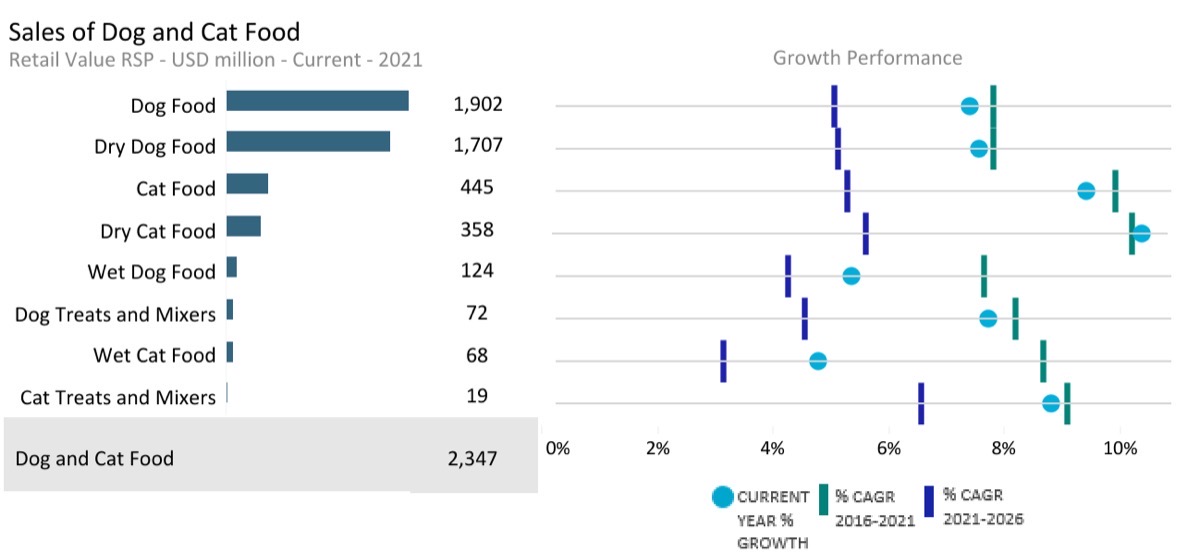
Note: Current year growth in the above chart refers to the period 2020-21
Category
Unit
Market size (2021)
Retail value RSP
Forecast compound annual growth rate (2021/2026) %
Dog and Cat Food
USD million
2,347.27
5.10
Dog Food
USD million
1,901.82
5.06
Dog Treats and Mixers
USD million
71.59
4.54
Dry Dog Food
USD million
1,706.68
5.14
Wet Dog Food
USD million
123.56
4.26
Cat Food
USD million
445.45
5.28
Wet Cat Food
USD million
68.35
3.16
Dry Cat Food
USD million
358.12
5.59
Cat treats and mixers
USD million
18.98
6.58
- Channel distribution
-
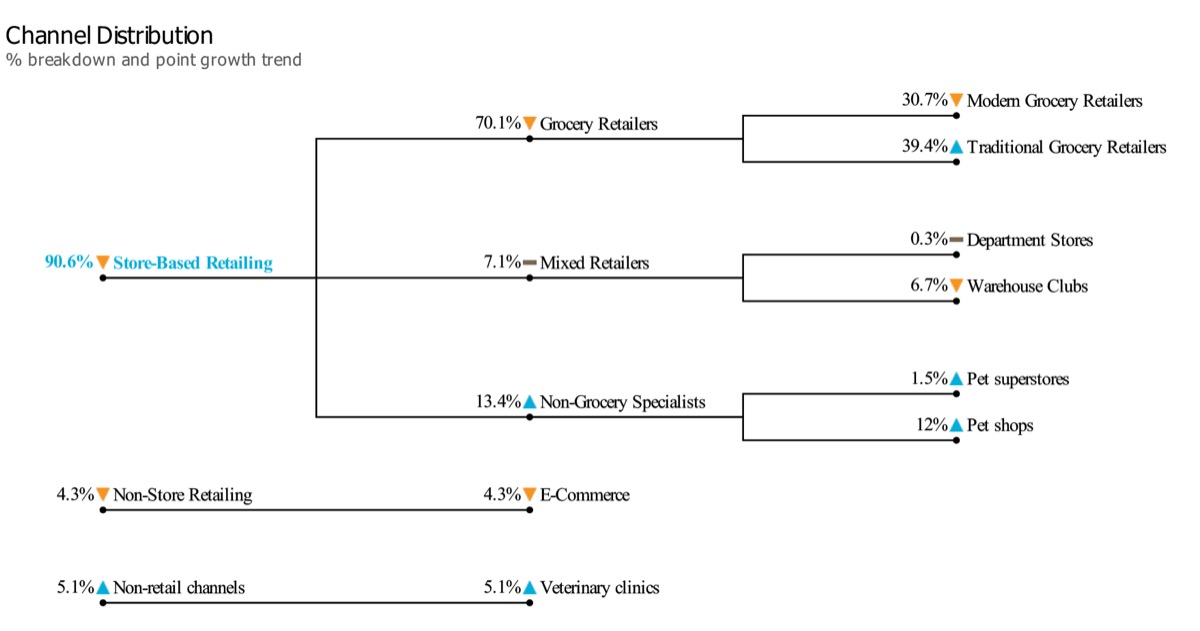
Note: The chart here showcases the retail value share of different channel sales for dog and cat food products in Mexico in 2021. The triangle/dash represents whether the specific channel share has increased/decreased or remained the same against its share in the previous year.
- Market Insights
-
Market trends
- Due to the outbreak of the pandemic and with majority of the Mexicans being concerned about their financial security, a noticeable slowdown has been recorded for premium pet care products. Sales of wet food have been impacted by consumers trading down, with some consumers perceiving such products as non-essential when making financial choices. As such, in 2021, growth is being driven by dry dog food on the dog food landscape, whereas before the outbreak, premium options were leading value growth. Financial concerns are also leading to a slowdown in the dog population for 2021, with many being wary of the higher cost of keeping a dog compared to alternative pet options.
- While the dog population is experiencing a slowdown, adoption of cats is experiencing the opposite due to the perception that they are easier to look after at a lower cost. In addition, due to the virus outbreak and home seclusion, many owners looked for new pets to occupy their time or keep them company, with cats being the preferred choice economically. The cat ownership rates are more noticeable in urban households, lacking space for larger animals such as dogs.
Prospects and growth opportunity
- Following the outbreak of COVID-19 in Mexico, a slow economic recovery is expected over the forecast period (2021-2026). With this, sales of wet food are expected to accelerate as consumers feel financially secure. With dogs considered important family members by Mexicans, when finances allow it, owners will be willing to give their pets the best food they can. This will lead to premium therapeutic dry dog food leading value growth over the forecast period as consumption of premium dog food increases. Millennials in particular, will be seen spending more than the average household on food for their dogs.
- Similarly, over the forecast period for cat food, premiumisation is set to continue, with the arrival of new brands and the evolution of established ones set to take place. Premium brands appeal to cat owners who are looking to create a special bond with their cats and are concerned about their nutrition. They are willing to spend more on cat food as, unlike dog owners, they do not need to purchase other items such as clothing or leashes.
- Neovia has highlighted that focusing on the premium segment is the way to increase sales of cat food, with the company planning to make significant investments in this area. Nestlé, meanwhile, has been promoting the segment with the launch of Purina Felix Travesuras at the end of the review period. The player offers a line of treats developed for cats that compete directly with Whiskas Temptations, one of the only cat treats brands available in supermarkets, as well as against other cat treats sold in pet shops and pet superstores, including Natural Purrz, Smart n’ Tasty, Petit Monster, Pop’n bites or cat bites. Cat treats one of the smallest categories within pet food and has been underdeveloped for several years. However, increasing interest in cats will boost demand for more options to entertain and feed them, leading to cat treats and mixers driving strong value growth across the forecast period to 2026.
General health & wellness trends
- Over the forecast period (2021-2026), the wide range of brands and prices on offer within dog food will allow consumers from different income segments to try prepared dog food for the first time or increase their dog food consumption with a mix of wet and dry food. The proportion of dogs eating prepared dog food in Mexican households will continue to grow each year. Owners that buy wet dog food increasingly want to see recognisable meat and vegetable chunks in their pets’ meals as they perceive such pieces to be more natural or less processed. In the case of both wet and dry dog food, the top flavours are bacon, fish, and sausage, while new options include chicken wings, almonds, burrito and jerky.
- Wet cat food is also becoming increasingly popular amongst Mexican cat pet owners. The stronger smell of the product means it is often more appealing to cats, stimulating their appetite and encouraging them to drink more water. Increasing demand for more wet cat food options encourages manufacturers to develop new flavours and formulas to add value to their products and greater benefits to enhance cat health. Owners that buy wet cat food wish to see meat and vegetable ingredients clearly in their pets’ food, indicating that the products are more natural and less processed. On the other hand, dry cat food is favoured by some cat owners as it is less messy, easier to store, does not dry out, and is better for a cat’s oral health.
Alcoholic Drinks
- Market size and growth
-
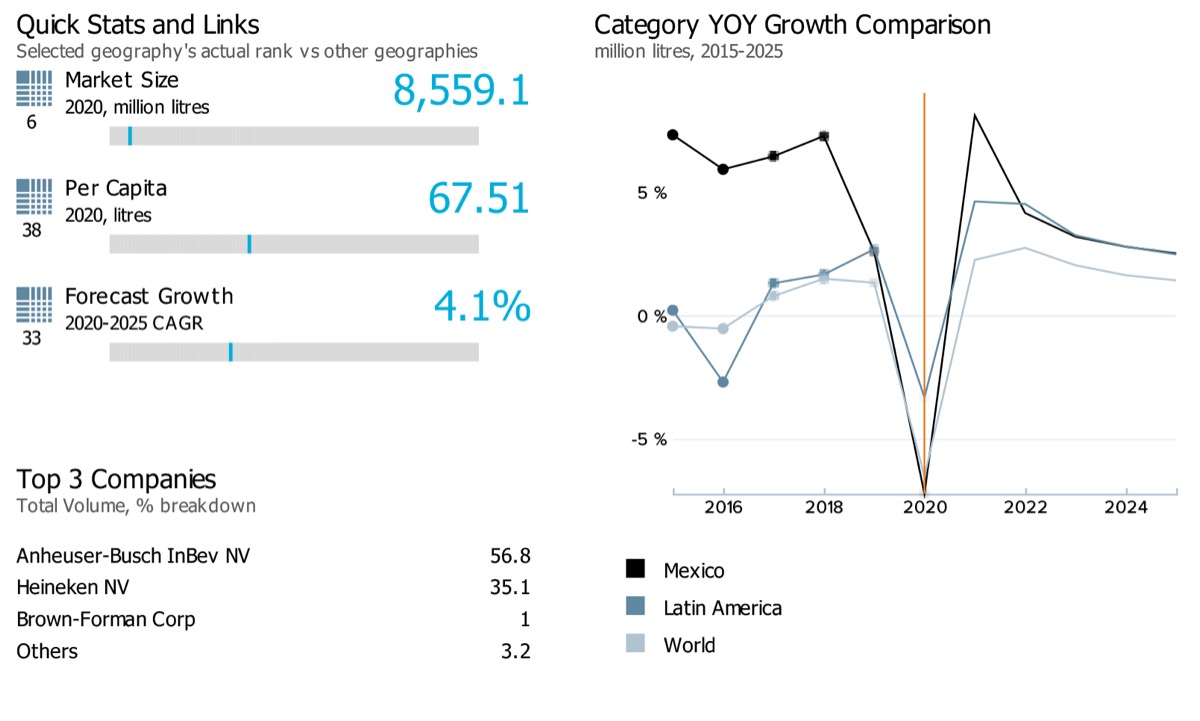
Note: Market size data for the alcoholic drinks category in the country reflects the total volume in million litres. Data on the top left corner of the image (6, 38 and 33) showcases respective ranks for Mexico for its market size, per capita, and forecast growth rate compared against 99 countries globally. The blue line on the grey bar represents the relative position of the country as per their rank.
The compound annual growth rate (CAGR) for alcoholic drinks in Mexico, both in terms of total value and volume, is expected to gain momentum over the forecast period (2020-2025: FCAGR for total value: 7.6% and for total volume: 4.1% ) against its performance in the historic period (2015-2020: HCAGR for total value: 4.9% and for total volume: 2.8%). This is mainly in line with the category’s performance at the global level, where both in terms of total value and volume, alcoholic drinks are expected to gain momentum over the forecast period (2020-2025: FCAGR for total value: 4.6% and for total volume: 2.0% ) against its performance in the historic period (2015-2020: HCAGR for total value: 0.9% and for total volume: -0.7% )
- Sub-category breakdown
-
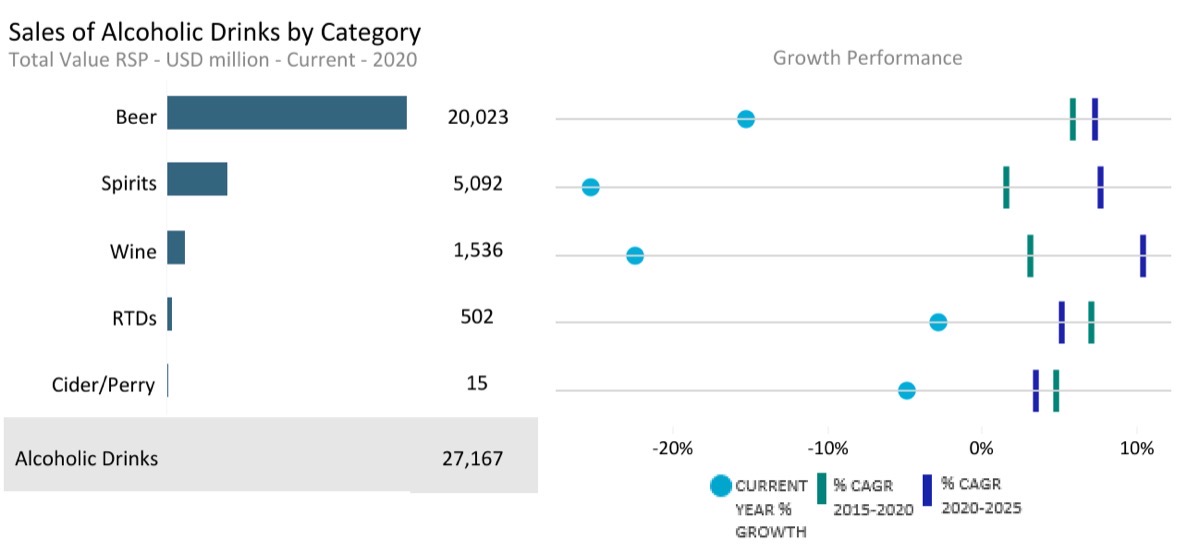
Current year growth in the above chart refers to the period 2019-20
Category
Data type
Market size (2020)
USD million
Forecast compound annual growth rate (2020/2025) %
Alcoholic Drinks
Total Value RSP
27,166.71
7.56
Alcoholic Drinks
Off-trade Value RSP
16,676.23
3.58
Alcoholic Drinks
On-trade Value RSP
10,490.48
12.88
Beer
Total Value RSP
20,022.86
7.37
Beer
Off-trade Value RSP
12,892.24
3.68
Beer
On-trade Value RSP
7,130.62
12.97
Cider/Perry
Total Value RSP
14.74
3.54
Cider/Perry
Off-trade Value RSP
12.82
2.51
Cider/Perry
On-trade Value RSP
1.92
9.56
RTDs
Total Value RSP
501.69
5.19
RTDs
Off-trade Value RSP
438.75
4.02
RTDs
On-trade Value RSP
62.94
12.14
Spirits
Total Value RSP
5,091.58
7.62
Spirits
Off-trade Value RSP
2,574.42
2.63
Spirits
On-trade Value RSP
2,517.16
11.91
Wine
Total Value RSP
1,535.83
10.41
Wine
Off-trade Value RSP
757.99
4.61
Wine
On-trade Value RSP
777.84
15.09
- Channel distribution
-

Note: The chart here showcases the off-trade volume share of different channel sales for alcoholic drink products in Mexico in 2020. The triangle/dash represents whether the specific channel share has increased/decreased or remained the same against its share in the previous year.
- Market Insights
-
Market trends
- The outbreak of COVID-19 in Mexico led to a total volume decline of 7% in 2020, compared to total volume growth of 3% in 2019. On-trade sales were the most negatively impacted, recording a double-digit decline due to the closure of all HORECA (Hotel/Restaurant/Café) outlets, including pubs, bars, restaurants and cafés. However, off-trade volume growth for alcoholic drinks was more positive, aligned to total volume recorded in 2019. With consumers unable to visit on-trade establishments, some of this growth was due to consumers transferring their on-trade drinking to at-home consumption moments.
- Furthermore, with many consumers in the country impacted by the outbreak of COVID-19, growing anxieties and concerns meant that some increased their home consumption of products such as beer and wine to relax in the evenings. However, spirits and RTDs both recorded stifled growths, with these being more associated with social gatherings, which were not happening.
- While also recording growth, cider/perry continued to be impacted by being a seasonal drink in Mexico; therefore, a lack of larger events during Christmas and New Year impacted sales. Despite this, the landscape benefited from price sensitivity rising, leading consumers to trade down from sparkling wine to cider. In addition, price-conscious behaviour also helped RTDs, with consumers trading down from spirits to these more affordable options.
Prospects and growth opportunity
- In spirits, Craft spirits are expected to gain relevance over the forecast period as consumers become increasingly knowledgeable. Spirits such as mezcal and pulque (fermented agave juice) are associated with artisanal processes, but they are not necessarily perceived as craft spirits. Over the forecast period (2020-2025), companies are expected to invest in communication strategies that encourage consumers to differentiate between artisanal and craft products. The latter is expected to be positioned as high-quality beverages that maintain their essence through high-quality ingredients and precise production processes.
- In response to limited operating hours, many retailers took to exploring alternative sales options, including e-commerce. Both brands and retailers improved their e-commerce presence, with this channel not being impacted by the restrictions and measures. As such, e-commerce experienced a major boost in sales during the year. Over the forecast period, the channel is expected to gain further relevance, with consumers having become familiar with the ordering process and confident of the legitimacy of this channel during 2020. The convenience offered by online shopping, including delivering heavy goods directly to the consumer’s doorstep, will continue to expand sales. As new users have adapted and become accustomed to the channel, this presents an opportunity for players to focus on their e-commerce presence across the forecast period.
General industry trends
- The outbreak of COVID-19 is expected to increase consumers’ further interest in health and wellbeing over the forecast period. In turn, this is likely to result in strong total volume growth for options such as non/low alcohol beer, with innovations focusing on low-calorie options, such as hard seltzers, while using natural ingredients to appeal to health-consciousness consumers.
- Also, as consumers return to socialising, sparkling wine is forecast to record high levels of volume growth, appreciated for being an affordable option, lower in calories than other wine options. While some consumers may continue to trade down from sparkling wine to cider across the early forecast period, cider will continue to be challenged by its association with being a seasonal product, limiting sales throughout the coming years.
Health & Wellness Packaged Food & Beverages
- Market size and growth
-
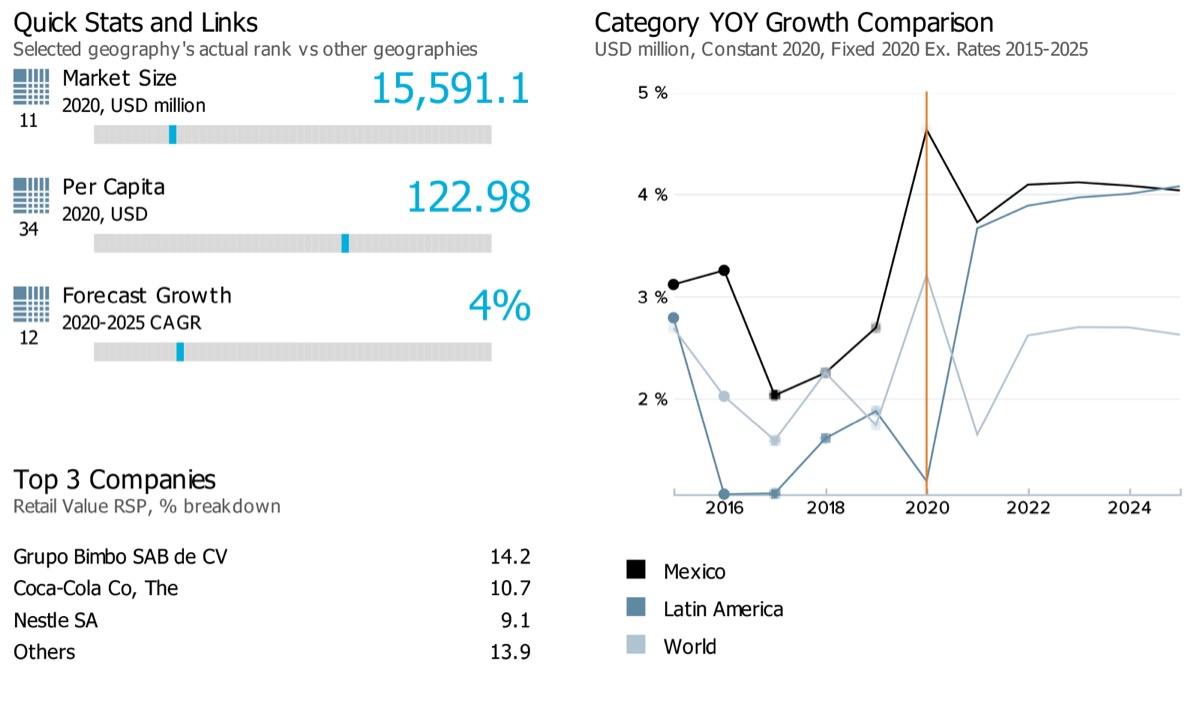
Note: Data on the top left corner of the image (11, 34 and 12) showcases respective ranks for Mexico for its market size, per capita, and forecast growth rate compared against 53 countries globally. The blue line on the grey bar represents the relative position of the country as per their rank.
The retail value sales of health and wellness food and beverage products in Mexico is expected to slow down when comparing the compound annual growth rates from historic to forecast periods, i.e. (7.2% during 2015-2020 to 4.0% during 2020-2025). This was also the case with the category’s performance at the global level, where its compound annual growth rate for retail value sales is estimated to slow down from 4.6% during 2015-2020 to 2.4% during 2020-2025.
- Sub-category breakdown
-
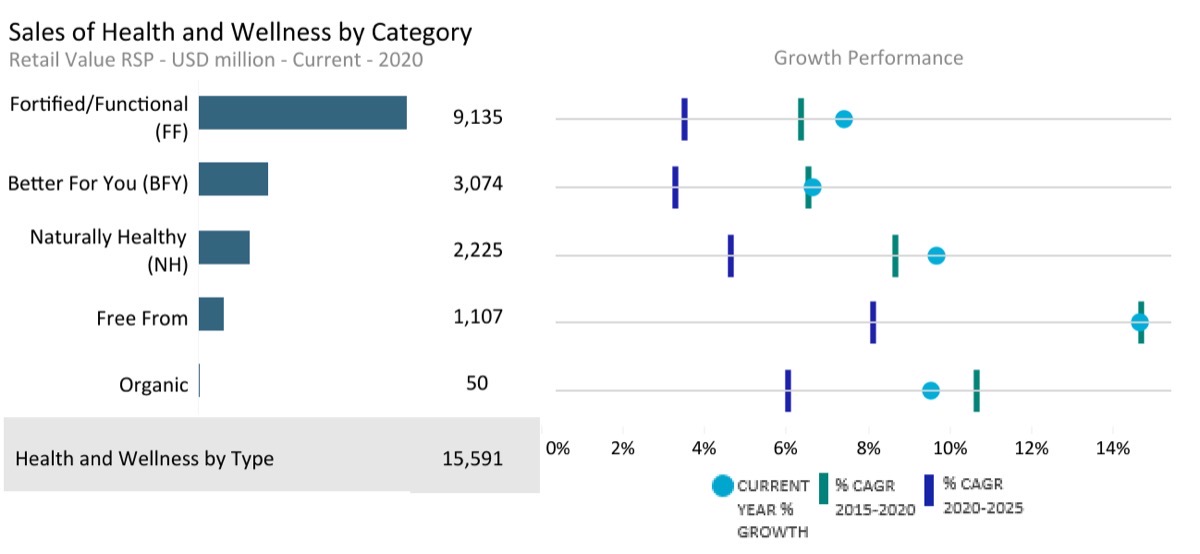
Current year growth in the above chart refers to the period 2019-20
Category
Unit
Market size (2020)
Retail value RSP
Forecast compound annual growth rate (2020/2025) %
Health and Wellness by Type
USD million
15,591.07
4.01
Better For You (BFY)
USD million
3,073.83
3.29
Fortified/Functional (FF)
USD million
9,134.69
3.53
Free From
USD million
1,107.25
8.14
Naturally Healthy (NH)
USD million
2,225.25
4.64
Organic
USD million
50.05
6.03
- Channel distribution
-

Note: The chart here showcases the retail value share of different channel sales for health and wellness by type products in Mexico in 2020. The triangle/dash represents whether the specific channel share has increased/decreased or remained the same against its share in the previous year.
- Market Insights
-
Market trends
- Stockpiling at the beginning of the COVID-19 pandemic in 2020 benefited cheaper products with longer shelf lives, especially benefiting fortified/functional products with the inclusion of vitamins to boost immunity. The focus on food and nutrition increased during 2020 as the government heavily emphasised the vulnerability of people with obesity, diabetes and high blood pressure when battling COVID-19. This favoured sales of naturally healthy products as consumers were increasingly aware of the relevance of their eating habits and were looking to shift towards healthier alternatives.
- In FF (fortified/functional) packaged food category, FF dairy products led the category, with FF milk and FF yoghurt being among the biggest contributors. For years, many manufacturers of these products have communicated the fortified/functional attributes of their ranges, which are therefore well positioned amongst consumers. However, over the review period (2015-2020), there was a noticeable shift towards using more specific messages regarding product fortification and functionality. A noticeable example is the milk brand Lala (Grupo Lala SAB de CV), which offers milk with 30% more calcium and 70% more protein than standard milk. The addition of fibre has also been observed more frequently amongst FF dairy products.
Prospects and growth opportunity
- With regards to FF (fortified/functional) beverages, over the last five years, added vitamins have been an affordable way for brand owners to add value to their products, and considering the economic impact of the pandemic, this strategy will likely continue and spread to other categories such as flavoured water and RTD tea. Also, there is expected to be a reversal of the premiumisation trend over the coming few years as products such as cold brews and functional waters that were beginning their foray into a consumer base with rising incomes finds themselves stuck in the post-pandemic recovery.
- Sales of FF beverages continued to be led by Coca-Cola Mexico in 2020. The company offers a very popular brand in the large and vibrant FF sports drinks category, Powerade, which is also the leading brand overall. The company also offers the Glacéau VitaminWater brand, the dominant name in FF bottled water. Coca-Cola also participates in reduced sugar sports drinks with its Powerade Zero brand, meaning it is covering both parts of FF sports drinks with Powerade competing in the regular category. In addition to its well-positioned brands, Coca-Cola’s leadership is explained by its well-developed distribution network, which has national coverage through a wide number of retailers.
- For FF (fortified/functional) packaged food products, communication strategies are expected to play a key role over the forecast period as companies try to reach their target customers. Packaging will become especially relevant as more brands are displayed on the shelves, and consumers become more used to comparing formats, ingredients and benefits. Health claims are likely to become more specific, and more information about those benefits is expected to be available for consumers. Over the forecast period to 2025, it is projected that brands will use creative and innovative ways to highlight the protein, calcium, fibre and vitamin content in their products.
General health & wellness trends
- Over the forecast period (2020-2025), sales of health and wellness packaged food and beverage are expected to be driven by consumers being keen to stay healthy as COVID-19 has brought to light the consequences of an unhealthy diet. In the short term, this means preparing meals at home, whilst it will result in consumers valuing products with health claims in the long term. Sales will also be driven by the increased availability of health and wellness brands and products. Companies are likely to develop more sophisticated products to add value to their portfolios and match the preferences and habits of consumers.
- To provide consumers with visible and accurate product information and curb the increasing obesity rate in Mexico, a new product labelling regulation was introduced in 2020, requiring companies to place black octagonal seals on products with excess sugar and calories, sodium, or fat. It is expected to have an important impact on health and wellness products going forward as the seals may negate certain products’ claimed benefits. Also, over the forecast period to 2025, companies are likely to reformulate their products to avoid placing black warning seals.
Retail Landscape
- Brand shares of supermarkets
-
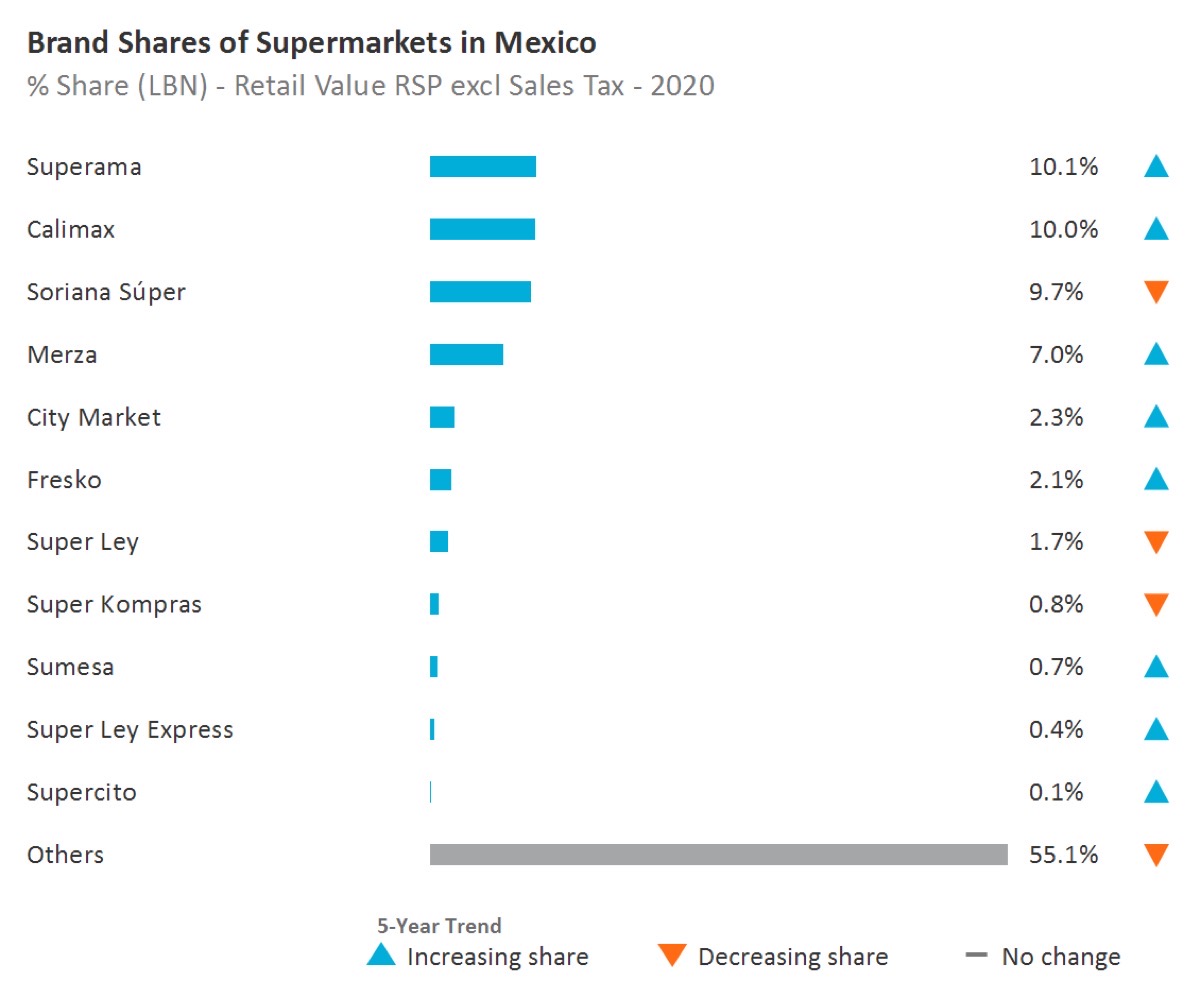
- Brand shares of chemists/pharmacies
-

- Retail insights
-
- When Mexican consumers resume their busy lives and start going out again as the fear of COVID-19 subsides over the next few years, supermarkets’ retail value growth is expected to decelerate. As a mature channel in Mexico, supermarkets usually see steady sluggish growth, and this trend is likely to reoccur when the COVID-19 pandemic subsides. Growth within this channel is often led by new store openings, some of which were put on hold in 2020 due to COVID-19, but companies have started returning to their plans for growth in 2021. Following this, growth rates are likely to return to pre-Covid levels. Promotions and overall low prices will be key to maintaining sales growth, especially when competing against the lower prices of discounters. Larger companies such as Walmart’s Superama would take advantage of their scale and apply savings to their supermarket banners.
- Mexicans have been resistant to e-commerce for a long time, especially in the grocery retailers’ channel. Historically there have been three major factors limiting e-commerce expansion in grocery retailers. The first is simply that Mexican consumers are not comfortable with it; they typically prefer to pick produce and other items for themselves and struggle with not seeing what they are buying. The second is that many Mexican consumers either rely entirely on cash and do not own a credit card or prefer cash security and are wary of the safety concerns when using a card online. Thirdly, the delivery networks in Mexico, especially outside of major cities, are more limited and cannot accommodate the rapid delivery that is required when delivering grocery items. However, the COVID-19 pandemic pushed many consumers to try online grocery shopping as they were wary of entering physical stores. While some consumers are likely to return to in-person shopping when COVID-19 is under control, a good proportion of them are expected to continue using e-commerce for their grocery shopping due to this channel’s convenience. Offering cash payment options, quality products, and quick delivery times will be key in securing online supermarket customers through the forecast period (2020-2025).
- The country's chemist/pharmacies market was valued at USD 9,661.3 million in 2020 (Retail value RSP without sales tax). In 2020-2021, the channel's year-over-year growth rate was estimated to be at 7.5%. The value compound annual growth rate was recorded as 6.9% over the last five years (2015-2020). However, over the forecast period, the channel's retail value compound annual growth rate is expected to grow back to 7.9% for the period 2020-2025.
- Definitions
- Acronyms Used & Key Notes
Definitions
|
Industry |
Category |
Definition |
|---|---|---|
|
Alcoholic Drinks |
Alcoholic Drinks |
Alcoholic drinks are the aggregation of beer, wine, spirits, cider/perry and RTDs. |
|
Alcoholic Drinks |
Beer |
An alcoholic drink usually brewed from malt, sugar, hops and water and fermented with yeast. Some beers are made by fermenting a cereal, especially barley, and therefore not flavoured by hops. Alcohol content for beer is varied – anything up to and over 14% ABV (alcohol by volume), although 3.5% to 5% is most common. Beer is the aggregation of lager, dark beer, stout and non/low alcohol beer. |
|
Alcoholic Drinks |
Cider/Perry |
Cider is made from fermented apple juice while perry is made from fermented pear juice. Both artisanal and industrial cider/perry are included. |
|
Alcoholic Drinks |
RTDs |
RTD stands for ‘ready-to-drink’. Other terms which may be used for these products are FABs, alcopops and premixes. The RTDs sector is the aggregation of malt-, wine-, spirit- and other types of premixed drinks. These drinks usually have an alcohol content of around 5% but this can reach as high as 10% ABV. Premixes containing a high percentage of alcohol of around 15%+ combined with juice or any other soft drink are included here. RTDs are usually marketed as products to be drunk neat, with ice, or as a cocktail ingredient. Fruit-flavoured, vodka-based spirits with an alcohol content of between 16-21% are classified here. Examples: Alizé, Ursus Roter, Berentzen Fruchtige, Kleiner Feigling. |
|
Alcoholic Drinks |
Spirits |
This is the aggregation of whisk(e)y, brandy and Cognac, white spirits, rum, tequila, liqueurs and other spirits. |
|
Alcoholic Drinks |
Wine |
This is the aggregation of still and sparkling light grape wines, fortified wine and vermouth and non-grape wine. In terms of alcohol content, light wine usually falls into the 8-14% ABV bracket while fortified wine ranges from 14-23% ABV. Low and non-alcoholic wine is also included in the data (attributed to each sector as appropriate). |
|
Beauty and Personal Care |
Skin Care |
This is the aggregation of facial care, body care, hand care and skin care sets/kits. |
|
Beauty and Personal Care |
Body Care |
This is the aggregation of firming/anti-cellulite products and general-purpose body care. |
|
Beauty and Personal Care |
Facial Care |
This is the aggregation of acne treatments, moisturisers and treatments, facial cleansers, toners, face masks, and lip care. Please note that Moisturisers and Treatments is the aggregation of basic moisturisers and anti-agers. |
|
Beauty and Personal Care |
Hand Care |
Includes all hand moisturisers, both premium and mass market, as well as combination hand and nail products. Includes protective emollients and deep moisturisers formulated to sooth and hydrate very dry or irritated skin, as well as those that prevent, or that are suitable for, eczema-prone or redness-prone skin. Excludes medicated emollients and/or those positioned as treatment for eczema or psoriasis. |
|
Beauty and Personal Care |
Skin Care Sets/Kits |
Multiple skin care items of the same brand line packaged together in a set and priced at an advantageous price compared to purchasing the items separately. Includes traditional gift sets, multi-step skin care regimens, skin care starter kits (including acne treatment regimen sets/kits) and skin care travel kits (sold through retail outlets). Also includes sets, which comprise of products from multiple categories (e.g. makeup and skin care), as long as the primary product is skin care. Men’s, women’s and unisex versions are included. Excludes: GWP (Gift with Purchase) – consumer does not pay for this (e.g. free product when you purchase a set or a free sample kit). |
|
Consumer Health |
Dietary Supplements |
It is the aggregation of all dietary supplements: Minerals, fish oils/omega fatty acids, garlic, ginseng, ginkgo biloba, evening primrose oil, Echinacea, St John's Wort, protein supplements, probiotic supplements, eye health supplements, co-enzyme Q10, glucosamine, combination herbal/traditional supplements, non-herbal/traditional supplements, and all other dietary supplements specific to country coverage. |
|
Consumer Health |
Paediatric Vitamins and Dietary Supplements |
All vitamin and dietary supplement products formulated, designed, marketed and labelled specifically for children. |
|
Consumer Health |
Tonics |
Include versions of combination dietary supplements that are sold in the format of liquid concentrates, mini-drinks, shots or oral gels. Include concentrated energy shot boosters and tonics such as 5-Hour Energy and Lipovitan. Exclude remedies made with active pharmaceutical ingredients as well as super fruit juice concentrates and weight-loss beverages, tracked under the Health and Wellness (HW) system. |
|
Consumer Health |
Vitamins |
This is the aggregation of multivitamins and single vitamins. |
|
Health and Wellness |
Health and Wellness by Type |
Health and Wellness by Type is the aggregation of all health and wellness food and beverages broken down by organic, fortified/functional, naturally healthy, better for you and free from products. |
|
Health and Wellness |
Better For You (BFY) |
Products where the amount of a substance considered to be less healthy (eg fat, sugar, salt, carbohydrates) has been actively reduced during production. To qualify for inclusion in this category, the “less healthy” element of the foodstuff needs to have been actively removed or substituted during the processing. This should also form a key part of the positioning/marketing of the product. Products which are naturally fat/sugar/carbohydrate -free are not included as nothing out of the ordinary has been done during their production to make them “better for you”. “No added sugar” claims are excluded too. Products most likely to be included here will be those which are low-fat/low-sugar versions of standard products (i.e. reduced fat mayonnaise, reduced fat cheese, reduced fat milk, reduced sugar confectionery, etc). |
|
Health and Wellness |
Fortified/Functional (FF) |
This category includes fortified/functional food and beverages. When identifying fortified/functional products, we focus on products to which health ingredients or/and nutrients have been added as well as brands that are positioned to deliver a certain functionality. To be included here the enhancement must be highlighted in the label or hold a health claim/nutritional claim. Fortified/functional food and beverages provide health benefits beyond their nutritional value and/or the level of added ingredients wouldn’t normally be found in that product. To merit inclusion in this category, the defining criterion here is that the product must have been actively fortified/enhanced during production. As such, inherently healthy products such as 100% fruit/vegetable juices are only included under "fortified/functional" if additional health ingredients (e.g. calcium, omega 3) have been added. To be included, the health benefit needs to form part of positioning/marketing of the product. For product category definitions please refer to the definitions section (can be found under the "Help" section on Passport) for the respective system: Packaged Food, Hot Drinks, Soft Drinks. |
|
Health and Wellness |
Free From |
This category includes free from gluten, free from lactose, free from allergens, free from dairy and free from meat products. This excludes foods which are certified ‘free’ of a specific product when this is based on use of sterilised equipment. |
|
Health and Wellness |
Naturally Healthy (NH) |
This category includes food and beverages based on naturally containing a substance that improves health and wellbeing beyond the product’s pure calorific value. These products are usually a healthier alternative within a certain sector/subsector. High fibre food (wholegrain/wholemeal/brown), soy products, sour milk drinks, nuts, seeds and trail mixes, honey, fruit and nut bars and olive oil are considered NH foods and 100% fruit/vegetable juice, superfruit juice, natural mineral water, spring water, RTD green tea etc. are considered NH beverages. While many of these products are marketed on a health basis, this might not always be the case. Naturally healthy food and beverages that are additionally fortified fall into the 'fortified/functional' category. |
|
Health and Wellness |
Organic |
Certified organic products are those which have been produced, stored, processed, handled and marketed in accordance with precise technical specifications (standards) and certified as "organic" by a certification body such as the Soil Association in the UK, the European Union or the US Department of Agriculture. It is important to note that an organic label applies to the production process, ensuring that the product has been produced and processed in an ecologically sound manner. The organic label is therefore a production process claim as opposed to a product quality claim. Note: For organic products to be included, the organic aspect needs to form a significant part of the overall positioning/marketing of the product, including the organic certification label in the packaging. |
|
Pet Care |
Dog and Cat Food |
This is the aggregation of dog and cat food. |
|
Pet Care |
Cat Food |
This is the aggregation of wet and dry cat food. |
|
Pet Care |
Cat Treats and Mixers |
This is the aggregation of mixers and treats for cats. |
|
Pet Care |
Dry Cat Food |
These products have a moisture content of 10-14% and are generally packed into paper, plastic or cardboard. Dry cat food is typically made from a combination of grain-based ingredients (corn and rice) and a meat component. It is typically produced by extrusion cooking under high heat and pressure and then sprayed with fat to increase palatability. Other ingredients may also be added to complete its composition. This is the aggregation of premium, mid-priced and economy dry cat food. Note: semi-moist food is included here. These products are extruded (combining meat and cereal), have a higher moisture content (20-40%) and are usually packaged in plastic or foil sachets. |
|
Pet Care |
Wet Cat Food |
These products have a moisture content of 60-85% and are generally (though not always) preserved by heat treatment. They are packaged in steel or aluminium cans, rigid or flexible plastic or semi-rigid aluminium trays. This is the aggregation of premium, mid-priced and economy wet cat food. |
|
Pet Care |
Dog Food |
This is the aggregation of wet and dry dog food. |
|
Pet Care |
Dog Treats and Mixers |
This is the aggregation of mixers and treats for dogs. |
|
Pet Care |
Dry Dog Food |
These products generally have a moisture content of 6-14% and are generally packed into paper, plastic or cardboard. Complete dry dog foods fall into two broad categories: Flaked (or 'Muesli' type blended products) and Extruded products (meat and cereals cooked by direct steaming). This is the aggregation of premium, mid-priced and economy dry dog food. Note: semi-moist food is included here. These products are extruded (combining meat and cereal) have a higher moisture content (20-40%) and are usually packaged in plastic or foil sachets. |
|
Pet Care |
Wet Dog Food |
These products have a moisture content of 60-85% and are generally (though not always) preserved by heat treatment. They are packaged in steel or aluminium cans, rigid or flexible plastic or semi-rigid aluminium trays. This is the aggregation of premium, mid-priced and economy wet dog food. |
|
Retail in Alcoholic Drinks |
Store-Based Retailing |
Store-based retailing is the aggregation of grocery retailers and non-grocery specialists and mixed retailers. |
|
Retail in Alcoholic Drinks |
Grocery Retailers |
Retailers selling predominantly food/beverages/tobacco and other everyday groceries. This is the aggregation of hypermarkets, supermarkets, discounters, convenience stores, independent small grocers, forecourt retailers, food/drink/tobacco specialists and other grocery retailers. |
|
Retail in Alcoholic Drinks |
Convenience Stores |
Chained grocery retail outlets selling a wide range of groceries and fitting several of the following characteristics: Extended opening hours •Selling area of less than 400 sq. metres •Located in residential neighbourhoods •Handling two or more of the following product categories: audio-visual goods (for sale or rent), foodservice (prepared take-away, made-to-order, and hot foods), newspapers or magazines, cut flowers or pot plants, greetings cards, automotive accessories. Example brands include 7-Eleven, Spar. |
|
Retail in Alcoholic Drinks |
Discounters |
Discounters are retail outlets typically with a selling space of between 400 and 2,500 square metres. Retailers' primary focus is on selling private label products within a limited range of food/beverages/tobacco and other groceries at budget prices. Discounters may also sell a selection of non-groceries, frequently as short-term special offers. Discounters can be classified as hard discounters and soft discounters. Hard discounter: first introduced by Aldi in Germany, and also known as limited-line discounters. Retail outlets, typically of 300-900 square metres, stocking fewer than 1,000 product lines, largely in packaged groceries. Goods are mainly private-label or budget brands. Soft discounter: usually slightly larger than hard discounters, and also known as extended-range discounters. Retail outlets typically stocking 1,000-4,000 product lines. As well as private-label and budget brands, stores commonly carry leading brands at discounted prices. Discounters excludes mass merchandisers and warehouse clubs. Example brands include Aldi, Lidl, Plus, Penny, Netto. |
|
Retail in Alcoholic Drinks |
Forecourt Retailers |
Grocery retail outlets selling a wide range of groceries from a gas station forecourt and fitting several of the following characteristics: • Extended opening hours • Selling area of less than 400 sq. metres • Handling two or more of the following product categories: audio-visual goods (for sale or rent), take-away food (readymade sandwiches, rolls or hot food), newspapers or magazines, cut flowers or pot plants, greetings cards, automotive accessories. Example brands include BP Connect, Shell Select. Forecourt retailers includes both chained forecourt retailers and independent forecourt retailers. |
|
Retail in Alcoholic Drinks |
Hypermarkets |
Hypermarkets are retail outlets with a selling space of over 2,500 square metres and with a primary focus on selling food/beverages/tobacco and other groceries. Hypermarkets also sell a range of non-grocery merchandise. Hypermarkets are frequently located on out-of-town sites or as the anchor store in a shopping centre. Example brands include Carrefour, Tesco Extra, Géant, E Leclerc, Intermarché, Auchan. Excludes cash and carry, warehouse clubs and mass merchandisers. |
|
Retail in Alcoholic Drinks |
Supermarkets |
Retail outlets selling groceries with a selling space of between 400 and 2,500 square metres. Excludes discounters, convenience stores and independent grocery stores. Example brands include Champion, Tesco, Casino. |
|
Retail in Alcoholic Drinks |
Food/drink/tobacco specialists |
Retail outlets specialising in the sale of mainly one category of food, drinks store and tobacconists. Includes bakers (bread and flour confectionery), butchers (meat and meat products), fishmongers (fish and seafood), greengrocers (fruit and vegetables), drinks stores (alcoholic and non-alcoholic drinks), tobacconists (tobacco products and smokers’ accessories), cheesemongers, chocolatiers and other single food categories. Alcoholic drinks stores are retail outlets with a primary focus on selling beer/wine/spirits/other alcoholic beverages. Example brands include: Threshers, Gall & Gall, Liquorland, Watson’s Wine Cellar |
|
Retail in Alcoholic Drinks |
Independent Small Grocers |
Retail outlets selling a wide range of predominantly grocery products. These outlets are usually not chained and if chained will have fewer than 10 retail outlets. Mainly family owned, often referred to as Mom and Pop stores. |
|
Retail in Alcoholic Drinks |
Other Grocery Retailers |
Other retailers selling predominantly food, beverages and tobacco or a combination of these. Includes kiosks, markets selling predominantly groceries. Includes CTNs and health food stores, Food & drink souvenir stores and regional speciality stores. Direct home delivery, eg of milk, meat from farm/dairy is excluded. Sari-Sari stores in Philippines and Warung (Waroon) in Indonesia, that can either be markets or kiosks, are included in Other grocery retailers unless they occupy a separate permanent outlet building, in which case they are included in Independent small grocers. Outlets located within wet markets, particularly in South East Asia (often located in government-owned multi-story buildings) should be counted as separate outlets. Wine sales from Vineyards are included here. |
|
Retail in Alcoholic Drinks |
Non-Grocery Specialists |
Retail outlets selling predominantly non-grocery consumer goods. Non-grocery retailers is the aggregation of: • Apparel and footwear specialist retailers • Electronics and appliance specialist retailers • Health & beauty specialist retailers • Home and garden specialist retailers • Leisure and personal goods specialist retailers • Other non-grocery retailers |
|
Retail in Alcoholic Drinks |
Drugstores/parapharmacies |
Retail outlets selling mainly OTC healthcare, cosmetics and toiletries, disposable paper products, household care products and other general merchandise. Such outlets may also offer prescription-bound medicines under the supervision of a pharmacist. Drugstores in Spain (Droguerias) also sell household cleaning agents, paint, DIY products and sometimes pet products and services such as photo processing. Example brands include Rossmann (Germany), Kruidvat (Netherlands), Walgreen’s (US), CVS (US), Medicine Shoppe (US), Matsumoto Kiyoshi (Japan), HAC Kimisawa (Japan). |
|
Retail in Alcoholic Drinks |
Mixed Retailers |
This is the aggregation of department stores, variety stores, mass merchandisers and warehouse clubs. |
|
Retail in Alcoholic Drinks |
Department Stores |
Outlets selling mainly non-grocery merchandise and at least five lines in different departments, usually with a sales area of over 2,500 sq metres. They are usually arranged over several floors. Example brands include Macy’s, Bloomingdale’s, Marks & Spencer, Harrods, Sears, JC Penney, Takashimaya, Mitsukoshi, Daimaru, Karstadt, Rinascente. |
|
Retail in Alcoholic Drinks |
Mass Merchandisers |
Mixed retail outlets that usually: (1) convey the image of a high-volume, fast-turnover outlet selling a variety of merchandise for less than conventional prices; (2) provide centralised check-out service; and (3) provide minimal customer assistance within each department. Example brands include Wal-Mart, Target and Kmart. Excludes hypermarkets and warehouse clubs/cash and carry stores. |
|
Retail in Alcoholic Drinks |
Variety Stores |
Non-grocery general merchandise outlets usually located on one floor, offering a wide assortment of extensively discounted fast-moving consumer goods on a self-service basis. Normally over 1,500 sq. metres in size, except in the case of dollar stores, these outlets give priority to fast-moving non-grocery items that have long shelf-lives. Includes catalogue showrooms and dollar stores. Example brands include Woolworth (Germany), Upim (Italy). |
|
Retail in Alcoholic Drinks |
Warehouse Clubs |
Warehouse Clubs are chained outlets that sell a wide variety of merchandise but do have a strong mix of both grocery and non-grocery products. Customers have to pay an annual membership fee in order to shop. The clubs are able to keep prices low due to the no-frills format of the stores and attempt to drive volume sales through aggressive pricing techniques. Warehouse Clubs typically: - exceed 2,500 sq. metres of selling space and are invariably -over 4,000 sq. metres in size; - convey the image of a high-volume, fast-turnover retailing at less than conventional prices; - provide minimal customer assistance within each department; and - are situated in out-of-town locations. Example brands include: - Costco - Sam’s Club (Wal-Mart) - PriceSmart - Cost-U-Less |
|
Retail in Alcoholic Drinks |
Non-Store Retailing |
The retail sale of new and used goods to the general public for personal or household consumption from locations other than retail outlets or market stalls. Non-store retailing is the aggregation of Vending, Direct Selling, Homeshopping and Internet Retailing. |
|
Retail in Alcoholic Drinks |
Direct Selling |
Direct selling is the marketing of consumer goods directly to consumers, generally in their homes or the homes of others, at their workplace and other places away from permanent retail locations. Direct selling occurs in two primary ways: one-to-one basis (usually by prior arrangement a demonstration is given by a direct seller to a customer) or party-plan basis (selling through explanation and demonstration of products to a group of prospective customers by a direct seller usually in the home of a host(ess) who invites other persons for this purpose). |
|
Retail in Alcoholic Drinks |
Homeshopping |
Homeshopping is the sale of consumer goods to the general public via mail order catalogues, TV shopping and direct mail. Consumers purchase goods in direct response to an advertisement or promotion through a mail item, printed catalogue, TV shopping programme, or Internet catalogue whereby the order is placed, and payment is made by phone, by post or through other media such as digital TV. Excludes sales on returned products/unpaid invoices. Excludes sales ordered and paid online which are instead included within Internet retailing. |
|
Retail in Alcoholic Drinks |
E-Commerce |
Sales of consumer goods to the general public via the Internet. Please note that this includes sales through mobile phones and tablets. Internet retailing includes sales generated through pure e-commerce web sites and through sites operated by store-based retailers. Sales data is attributed to the country where the consumer is based, rather than where the retailer is based. Also includes orders placed through the web for which payment is then made through a storecard, an online credit account subsequent to delivery or on delivery of the product. This payment may be by any mode of payment including postal cheque, direct debit, standing order or other banking tools. Includes orders paid for cash on delivery. Includes m-commerce: where consumers use smart phones or tablets to connect to Internet and purchase the goods online. |
|
Retail in Alcoholic Drinks |
Vending |
Vending means automatic retailing. It covers the sale of products and services at an unattended point of sale through a machine operated by introducing coins, bank notes, payment cards, tokens or other means of cashless payment. Coverage includes vending systems installed in public and semi-captive environments only. Hotels, transport networks, recreational centres, shopping centres/malls are included. Factories, offices, hospitals, prisons, schools and other captive environments are excluded. |
|
Retail in Beauty and Personal Care |
Store-Based Retailing |
Store-based retailing is the aggregation of grocery retailers and non-grocery specialists and mixed retailers. |
|
Retail in Beauty and Personal Care |
Grocery Retailers |
Retailers selling predominantly food/beverages/tobacco and other everyday groceries. This is the aggregation of hypermarkets, supermarkets, discounters, convenience stores, independent small grocers, forecourt retailers, food/drink/tobacco specialists and other grocery retailers. |
|
Retail in Beauty and Personal Care |
Modern Grocery Retailers |
Modern grocery retailing is the aggregation of those grocery channels that have emerged alongside the growth of chained retail: Hypermarkets, Supermarkets, Discounters, Forecourt Retailers and Convenience Stores. |
|
Retail in Beauty and Personal Care |
Convenience Stores |
Chained grocery retail outlets selling a wide range of groceries and fitting several of the following characteristics: Extended opening hours •Selling area of less than 400 sq. metres •Located in residential neighbourhoods •Handling two or more of the following product categories: audio-visual goods (for sale or rent), foodservice (prepared take-away, made-to-order, and hot foods), newspapers or magazines, cut flowers or pot plants, greetings cards, automotive accessories. Example brands include 7-Eleven, Spar. |
|
Retail in Beauty and Personal Care |
Discounters |
Discounters are retail outlets typically with a selling space of between 400 and 2,500 square metres. Retailers' primary focus is on selling private label products within a limited range of food/beverages/tobacco and other groceries at budget prices. Discounters may also sell a selection of non-groceries, frequently as short-term special offers. Discounters can be classified as hard discounters and soft discounters. Hard discounter: first introduced by Aldi in Germany, and also known as limited-line discounters. Retail outlets, typically of 300-900 square metres, stocking fewer than 1,000 product lines, largely in packaged groceries. Goods are mainly private-label or budget brands. Soft discounter: usually slightly larger than hard discounters, and also known as extended-range discounters. Retail outlets typically stocking 1,000-4,000 product lines. As well as private-label and budget brands, stores commonly carry leading brands at discounted prices. Discounters excludes mass merchandisers and warehouse clubs. Example brands include Aldi, Lidl, Plus, Penny, Netto. |
|
Retail in Beauty and Personal Care |
Forecourt Retailers |
Grocery retail outlets selling a wide range of groceries from a gas station forecourt and fitting several of the following characteristics: • Extended opening hours • Selling area of less than 400 sq. metres • Handling two or more of the following product categories: audio-visual goods (for sale or rent), take-away food (ready-made sandwiches, rolls or hot food), newspapers or magazines, cut flowers or pot plants, greetings cards, automotive accessories. Example brands include BP Connect, Shell Select. Forecourt retailers includes both chained forecourt retailers and independent forecourt retailers. |
|
Retail in Beauty and Personal Care |
Hypermarkets |
Hypermarkets are retail outlets with a selling space of over 2,500 square metres and with a primary focus on selling food/beverages/tobacco and other groceries. Hypermarkets also sell a range of non-grocery merchandise. Hypermarkets are frequently located on out-of-town sites or as the anchor store in a shopping centre. Example brands include Carrefour, Tesco Extra, Géant, E Leclerc, Intermarché, Auchan. Excludes cash and carry, warehouse clubs and mass merchandisers. |
|
Retail in Beauty and Personal Care |
Supermarkets |
Retail outlets selling groceries with a selling space of between 400 and 2,500 square metres. Excludes discounters, convenience stores and independent grocery stores. Example brands include Champion, Tesco, Casino. |
|
Retail in Beauty and Personal Care |
Traditional Grocery Retailers |
Traditional grocery retailing is the aggregation of those channels that are invariably non-chained and are, therefore, owned by families and/or run on an individual basis. Traditional grocery retailing is the aggregation of three channels: Independent Small Grocers, Food/Drink/Tobacco Specialists and Other Grocery Retailers. |
|
Retail in Beauty and Personal Care |
Non-Grocery Specialists |
Retail outlets selling predominantly non-grocery consumer goods. Non-grocery retailers is the aggregation of: • Apparel and footwear specialist retailers • Electronics and appliance specialist retailers • Health & beauty specialist retailers • Home and garden specialist retailers • Leisure and personal goods specialist retailers • Other non-grocery retailers |
|
Retail in Beauty and Personal Care |
Apparel and Footwear Specialist Retailers |
Outlets specialising in the sale of all types of apparel, footwear and fashion accessories including costume jewellery, belts, handbags, hats, scarves or a combination of these (for example stores selling handbags only are included). This includes those stores that carry a combination of all products for either men or women or children and those that may specialise by either gender, age or product. Example brands include Gap, H&M, Zara, C&A, Miss Selfridge, Foot Locker, Uniglo, Next, Matalan. Brands that offer sports apparel and sports goods are excluded from Apparel and footwear specialist retailers and are included in Sports goods stores. |
|
Retail in Beauty and Personal Care |
Electronics and Appliance Specialist Retailers |
Retail outlets specialising in the sale of large or small domestic electrical appliances, consumer electronic equipment (including mobile phones), computers or a combination of these. For mobile phone retailers, this excludes revenues derived from telecoms service plans and top-up cards, etc. Example brands include Apple, Best Buy, Euronics, PC World, Darty, But, Media Markt, Yamada Denki, Gome (China). |
|
Retail in Beauty and Personal Care |
Health and Beauty Specialist Retailers |
This is the aggregation of chemists/pharmacies, drugstores/parapharmacies, beauty specialist retailers, optical goods stores and other healthcare specialist retailers. |
|
Retail in Beauty and Personal Care |
Beauty Specialist Retailers |
Beauty specialist retailers are chained or independent retail outlets with a primary focus on selling fragrances, other cosmetics and toiletries, beauty accessories or a combination of these. Examples of Beauty specialist retailer brands include: Body Shop, Marionnaud, Sephora and Bath and Body Works. |
|
Retail in Beauty and Personal Care |
Chemists/Pharmacies |
Retail outlets selling prescription-bound medicines under the supervision of a pharmacist and as its core activity (other activities include sales of OTC healthcare and cosmetics and toiletries products). |
|
Retail in Beauty and Personal Care |
Drugstores/parapharmacies |
Retail outlets selling mainly OTC healthcare, cosmetics and toiletries, disposable paper products, household care products and other general merchandise. Such outlets may also offer prescription-bound medicines under the supervision of a pharmacist. Drugstores in Spain (Droguerias) also sell household cleaning agents, paint, DIY products and sometimes pet products and services such as photo processing. Example brands include Rossmann (Germany), Kruidvat (Netherlands), Walgreen’s (US), CVS (US), Medicine Shoppe (US), Matsumoto Kiyoshi (Japan), HAC Kimisawa (Japan). |
|
Retail in Beauty and Personal Care |
Home and Garden Specialist Retailers |
This is the aggregation of homewares and home furnishing stores and home improvement and gardening stores. Business-to-business sales are excluded. Home improvement and gardening stores are chained or independent retail outlets with a primary focus on selling one or more of the following categories: Home improvement materials and hardware, Paints, coatings and wall coverings, Kitchen and bathroom, fixtures and fittings, Gardening equipment, House/Garden plants. Home improvement and gardening stores includes Home improvement centres / DIY stores, Hardware stores (Ironmongers), Garden centres, Kitchen and bathroom showrooms, Tile specialists, Flooring specialists. Homewares and Home Furnishing stores are retail outlets specialising in the sale of home furniture and furnishings, homewares, floor coverings, soft furnishings, lighting etc. |
|
Retail in Beauty and Personal Care |
Homewares and Home Furnishing Stores |
Retail outlets specialising in the sale of home furniture and furnishings, homewares, floor coverings, soft furnishings, lighting etc. |
|
Retail in Beauty and Personal Care |
Other Non-Grocery Specialists |
Other non-grocery retailers are chained or independent retail outlets, kiosks, market stalls or street vendors and with a primary focus on selling non-food merchandise. Other non-grocery retailers include Charity shops, Second-hand shops and Market stalls. |
|
Retail in Beauty and Personal Care |
Outdoor Markets |
Includes bazaars, kiosks, street vendors and beach vendors. |
|
Retail in Beauty and Personal Care |
Mixed Retailers |
This is the aggregation of department stores, variety stores, mass merchandisers and warehouse clubs. |
|
Retail in Beauty and Personal Care |
Department Stores |
Outlets selling mainly non-grocery merchandise and at least five lines in different departments, usually with a sales area of over 2,500 sq metres. They are usually arranged over several floors. Example brands include Macy’s, Bloomingdale’s, Marks & Spencer, Harrods, Sears, JC Penney, Takashimaya, Mitsukoshi, Daimaru, Karstadt, Rinascente. |
|
Retail in Beauty and Personal Care |
Mass Merchandisers |
Mixed retail outlets that usually: (1) convey the image of a high-volume, fast-turnover outlet selling a variety of merchandise for less than conventional prices; (2) provide centralised check-out service; and (3) provide minimal customer assistance within each department. Example brands include Wal-Mart, Target and Kmart. Excludes hypermarkets and warehouse clubs/cash and carry stores. |
|
Retail in Beauty and Personal Care |
Variety Stores |
Non-grocery general merchandise outlets usually located on one floor, offering a wide assortment of extensively discounted fast-moving consumer goods on a self-service basis. Normally over 1,500 sq. metres in size, except in the case of dollar stores, these outlets give priority to fast-moving non-grocery items that have long shelf-lives. Includes catalogue showrooms and dollar stores. Example brands include Woolworth (Germany), Upim (Italy). |
|
Retail in Beauty and Personal Care |
Warehouse Clubs |
Warehouse Clubs are chained outlets that sell a wide variety of merchandise but do have a strong mix of both grocery and non-grocery products. Customers have to pay an annual membership fee in order to shop. The clubs are able to keep prices low due to the no-frills format of the stores and attempt to drive volume sales through aggressive pricing techniques. Warehouse Clubs typically: - exceed 2,500 sq. metres of selling space and are invariably -over 4,000 sq. metres in size; - convey the image of a high-volume, fast-turnover retailing at less than conventional prices; - provide minimal customer assistance within each department; and - are situated in out-of-town locations. Example brands include: - Costco - Sam’s Club (Wal-Mart) - PriceSmart - Cost-U-Less |
|
Retail in Beauty and Personal Care |
Non-Store Retailing |
The retail sale of new and used goods to the general public for personal or household consumption from locations other than retail outlets or market stalls. Non-store retailing is the aggregation of Vending, Direct Selling, Homeshopping and Internet Retailing. |
|
Retail in Beauty and Personal Care |
Direct Selling |
Direct selling is the marketing of consumer goods directly to consumers, generally in their homes or the homes of others, at their workplace and other places away from permanent retail locations. Direct selling occurs in two primary ways: one-to-one basis (usually by prior arrangement a demonstration is given by a direct seller to a customer) or party-plan basis (selling through explanation and demonstration of products to a group of prospective customers by a direct seller usually in the home of a host(ess) who invites other persons for this purpose). |
|
Retail in Beauty and Personal Care |
Homeshopping |
Homeshopping is the sale of consumer goods to the general public via mail order catalogues, TV shopping and direct mail. Consumers purchase goods in direct response to an advertisement or promotion through a mail item, printed catalogue, TV shopping programme, or Internet catalogue whereby the order is placed, and payment is made by phone, by post or through other media such as digital TV. Excludes sales on returned products/unpaid invoices. Excludes sales ordered and paid online which are instead included within Internet retailing. |
|
Retail in Beauty and Personal Care |
E-Commerce |
Sales of consumer goods to the general public via the Internet. Please note that this includes sales through mobile phones and tablets. Internet retailing includes sales generated through pure e-commerce web sites and through sites operated by store-based retailers. Sales data is attributed to the country where the consumer is based, rather than where the retailer is based. Also includes orders placed through the web for which payment is then made through a storecard, an online credit account subsequent to delivery or on delivery of the product. This payment may be by any mode of payment including postal cheque, direct debit, standing order or other banking tools. Includes orders paid for cash on delivery. Includes m-commerce: where consumers use smart phones or tablets to connect to Internet and purchase the goods online. |
|
Retail in Beauty and Personal Care |
Vending |
Vending means automatic retailing. It covers the sale of products and services at an unattended point of sale through a machine operated by introducing coins, bank notes, payment cards, tokens or other means of cashless payment. Coverage includes vending systems installed in public and semi-captive environments only. Hotels, transport networks, recreational centres, shopping centres/malls are included. Factories, offices, hospitals, prisons, schools and other captive environments are excluded. |
|
Retail in Beauty and Personal Care |
Hair Salons |
Hair salons |
|
Retail in Health and Wellness |
Store-Based Retailing |
Store-based retailing is the aggregation of grocery retailers and non-grocery specialists and mixed retailers. |
|
Retail in Health and Wellness |
Convenience Stores |
Chained grocery retail outlets selling a wide range of groceries and fitting several of the following characteristics: Extended opening hours •Selling area of less than 400 sq. metres •Located in residential neighbourhoods •Handling two or more of the following product categories: audio-visual goods (for sale or rent), foodservice (prepared take-away, made-to-order, and hot foods), newspapers or magazines, cut flowers or pot plants, greetings cards, automotive accessories. Example brands include 7-Eleven, Spar. |
|
Retail in Health and Wellness |
Discounters |
Discounters are retail outlets typically with a selling space of between 400 and 2,500 square metres. Retailers' primary focus is on selling private label products within a limited range of food/beverages/tobacco and other groceries at budget prices. Discounters may also sell a selection of non-groceries, frequently as short-term special offers. Discounters can be classified as hard discounters and soft discounters. Hard discounter: first introduced by Aldi in Germany, and also known as limited-line discounters. Retail outlets, typically of 300-900 square metres, stocking fewer than 1,000 product lines, largely in packaged groceries. Goods are mainly private-label or budget brands. Soft discounter: usually slightly larger than hard discounters, and also known as extended-range discounters. Retail outlets typically stocking 1,000-4,000 product lines. As well as private-label and budget brands, stores commonly carry leading brands at discounted prices. Discounters excludes mass merchandisers and warehouse clubs. Example brands include Aldi, Lidl, Plus, Penny, Netto. |
|
Retail in Health and Wellness |
Forecourt Retailers |
Grocery retail outlets selling a wide range of groceries from a gas station forecourt and fitting several of the following characteristics: • Extended opening hours • Selling area of less than 400 sq. metres • Handling two or more of the following product categories: audio-visual goods (for sale or rent), take-away food (ready made sandwiches, rolls or hot food), newspapers or magazines, cut flowers or pot plants, greetings cards, automotive accessories. Example brands include BP Connect, Shell Select. Forecourt retailers includes both chained forecourt retailers and independent forecourt retailers. |
|
Retail in Health and Wellness |
Hypermarkets |
Hypermarkets are retail outlets with a selling space of over 2,500 square metres and with a primary focus on selling food/beverages/tobacco and other groceries. Hypermarkets also sell a range of non-grocery merchandise. Hypermarkets are frequently located on out-of-town sites or as the anchor store in a shopping centre. Example brands include Carrefour, Tesco Extra, Géant, E Leclerc, Intermarché, Auchan. Excludes cash and carry, warehouse clubs and mass merchandisers. |
|
Retail in Health and Wellness |
Supermarkets |
Retail outlets selling groceries with a selling space of between 400 and 2,500 square metres. Excludes discounters, convenience stores and independent grocery stores. Example brands include Champion, Tesco, Casino. |
|
Retail in Health and Wellness |
Independent Small Grocers |
Retail outlets selling a wide range of predominantly grocery products. These outlets are usually not chained and if chained will have fewer than 10 retail outlets. Mainly family owned, often referred to as Mom and Pop stores. |
|
Retail in Health and Wellness |
Other Grocery Retailers |
Other retailers selling predominantly food, beverages and tobacco or a combination of these. Includes kiosks, markets selling predominantly groceries. Includes CTNs and health food stores, Food & drink souvenir stores and regional speciality stores. Direct home delivery, e.g. of milk, meat from farm/dairy is excluded. Sari-Sari stores in Philippines and Warung (Waroon) in Indonesia, that can either be markets or kiosks, are included in Other grocery retailers unless they occupy a separate permanent outlet building, in which case they are included in Independent small grocers. Outlets located within wet markets, particularly in South East Asia (often located in government-owned multi-story buildings) should be counted as separate outlets. Wine sales from Vineyards are included here. |
|
Retail in Health and Wellness |
Non-Store Retailing |
The retail sale of new and used goods to the general public for personal or household consumption from locations other than retail outlets or market stalls. Non-store retailing is the aggregation of Vending, Direct Selling, Homeshopping and Internet Retailing. |
|
Retail in Health and Wellness |
Vending |
Vending means automatic retailing. It covers the sale of products and services at an unattended point of sale through a machine operated by introducing coins, bank notes, payment cards, tokens or other means of cashless payment. Coverage includes vending systems installed in public and semi-captive environments only. Hotels, transport networks, recreational centres, shopping centres/malls are included. Factories, offices, hospitals, prisons, schools and other captive environments are excluded. |
|
Retail in Health and Wellness |
Homeshopping |
Homeshopping is the sale of consumer goods to the general public via mail order catalogues, TV shopping and direct mail. Consumers purchase goods in direct response to an advertisement or promotion through a mail item, printed catalogue, TV shopping programme, or Internet catalogue whereby the order is placed, and payment is made by phone, by post or through other media such as digital TV. Excludes sales on returned products/unpaid invoices. Excludes sales ordered and paid online which are instead included within Internet retailing. |
|
Retail in Health and Wellness |
E-Commerce |
Sales of consumer goods to the general public via the Internet. Please note that this includes sales through mobile phones and tablets. Internet retailing includes sales generated through pure e-commerce web sites and through sites operated by store-based retailers. Sales data is attributed to the country where the consumer is based, rather than where the retailer is based. Also includes orders placed through the web for which payment is then made through a storecard, an online credit account subsequent to delivery or on delivery of the product. This payment may be by any mode of payment including postal cheque, direct debit, standing order or other banking tools. Includes orders paid for cash on delivery. Includes m-commerce: where consumers use smart phones or tablets to connect to Internet and purchase the goods online. |
|
Retail in Health and Wellness |
Direct Selling |
Direct selling is the marketing of consumer goods directly to consumers, generally in their homes or the homes of others, at their workplace and other places away from permanent retail locations. Direct selling occurs in two primary ways: one-to-one basis (usually by prior arrangement a demonstration is given by a direct seller to a customer) or party-plan basis (selling through explanation and demonstration of products to a group of prospective customers by a direct seller usually in the home of a host(ess) who invites other persons for this purpose). |
|
Retail in Pet Care |
Store-Based Retailing |
Store-based retailing is the aggregation of grocery retailers and non-grocery specialists and mixed retailers. |
|
Retail in Pet Care |
Grocery Retailers |
Retailers selling predominantly food/beverages/tobacco and other everyday groceries. This is the aggregation of hypermarkets, supermarkets, discounters, convenience stores, independent small grocers, forecourt retailers, food/drink/tobacco specialists and other grocery retailers. |
|
Retail in Pet Care |
Modern Grocery Retailers |
Modern grocery retailing is the aggregation of those grocery channels that have emerged alongside the growth of chained retail: Hypermarkets, Supermarkets, Discounters, Forecourt Retailers and Convenience Stores. |
|
Retail in Pet Care |
Convenience Stores |
Chained grocery retail outlets selling a wide range of groceries and fitting several of the following characteristics: Extended opening hours •Selling area of less than 400 sq. metres •Located in residential neighbourhoods •Handling two or more of the following product categories: audio-visual goods (for sale or rent), foodservice (prepared take-away, made-to-order, and hot foods), newspapers or magazines, cut flowers or pot plants, greetings cards, automotive accessories. Example brands include 7-Eleven, Spar. |
|
Retail in Pet Care |
Discounters |
Discounters are retail outlets typically with a selling space of between 400 and 2,500 square metres. Retailers' primary focus is on selling private label products within a limited range of food/beverages/tobacco and other groceries at budget prices. Discounters may also sell a selection of non-groceries, frequently as short-term special offers. Discounters can be classified as hard discounters and soft discounters. Hard discounter: first introduced by Aldi in Germany, and also known as limited-line discounters. Retail outlets, typically of 300-900 square metres, stocking fewer than 1,000 product lines, largely in packaged groceries. Goods are mainly private-label or budget brands. Soft discounter: usually slightly larger than hard discounters, and also known as extended-range discounters. Retail outlets typically stocking 1,000-4,000 product lines. As well as private-label and budget brands, stores commonly carry leading brands at discounted prices. Discounters excludes mass merchandisers and warehouse clubs. Example brands include Aldi, Lidl, Plus, Penny, Netto. |
|
Retail in Pet Care |
Forecourt Retailers |
Grocery retail outlets selling a wide range of groceries from a gas station forecourt and fitting several of the following characteristics: • Extended opening hours • Selling area of less than 400 sq. metres • Handling two or more of the following product categories: audio-visual goods (for sale or rent), take-away food (ready made sandwiches, rolls or hot food), newspapers or magazines, cut flowers or pot plants, greetings cards, automotive accessories. Example brands include BP Connect, Shell Select. Forecourt retailers includes both chained forecourt retailers and independent forecourt retailers. |
|
Retail in Pet Care |
Hypermarkets |
Hypermarkets are retail outlets with a selling space of over 2,500 square metres and with a primary focus on selling food/beverages/tobacco and other groceries. Hypermarkets also sell a range of non-grocery merchandise. Hypermarkets are frequently located on out-of-town sites or as the anchor store in a shopping centre. Example brands include Carrefour, Tesco Extra, Géant, E Leclerc, Intermarché, Auchan. Excludes cash and carry, warehouse clubs and mass merchandisers. |
|
Retail in Pet Care |
Supermarkets |
Retail outlets selling groceries with a selling space of between 400 and 2,500 square metres. Excludes discounters, convenience stores and independent grocery stores. Example brands include Champion, Tesco, Casino. |
|
Retail in Pet Care |
Traditional Grocery Retailers |
Traditional grocery retailing is the aggregation of those channels that are invariably non-chained and are, therefore, owned by families and/or run on an individual basis. Traditional grocery retailing is the aggregation of three channels: Independent Small Grocers, Food/Drink/Tobacco Specialists and Other Grocery Retailers. |
|
Retail in Pet Care |
Mixed Retailers |
This is the aggregation of department stores, variety stores, mass merchandisers and warehouse clubs. |
|
Retail in Pet Care |
Department Stores |
Outlets selling mainly non-grocery merchandise and at least five lines in different departments, usually with a sales area of over 2,500 sq. metres. They are usually arranged over several floors. Example brands include Macy’s, Bloomingdale’s, Marks & Spencer, Harrods, Sears, JC Penney, Takashimaya, Mitsukoshi, Daimaru, Karstadt, Rinascente. |
|
Retail in Pet Care |
Mass Merchandisers |
Mixed retail outlets that usually: (1) convey the image of a high-volume, fast-turnover outlet selling a variety of merchandise for less than conventional prices; (2) provide centralised check-out service; and (3) provide minimal customer assistance within each department. Example brands include Wal-Mart, Target and Kmart. Excludes hypermarkets and warehouse clubs/cash and carry stores. |
|
Retail in Pet Care |
Variety Stores |
Non-grocery general merchandise outlets usually located on one floor, offering a wide assortment of extensively discounted fast-moving consumer goods on a self-service basis. Normally over 1,500 sq. metres in size, except in the case of dollar stores, these outlets give priority to fast-moving non-grocery items that have long shelf-lives. Includes catalogue showrooms and dollar stores. Example brands include Woolworth (Germany), Upim (Italy). |
|
Retail in Pet Care |
Warehouse Clubs |
Warehouse Clubs are chained outlets that sell a wide variety of merchandise, but do have a strong mix of both grocery and non-grocery products. Customers have to pay an annual membership fee in order to shop. The clubs are able to keep prices low due to the no-frills format of the stores and attempt to drive volume sales through aggressive pricing techniques. Warehouse Clubs typically: - exceed 2,500 sq. metres of selling space and are invariably -over 4,000 sq. metres in size; - convey the image of a high-volume, fast-turnover retailing at less than conventional prices; - provide minimal customer assistance within each department; and - are situated in out-of-town locations. Example brands include: - Costco - Sam’s Club (Wal-Mart) - PriceSmart - Cost-U-Less |
|
Retail in Pet Care |
Non-Grocery Specialists |
Retail outlets selling predominantly non-grocery consumer goods. Non-grocery retailers is the aggregation of: • Apparel and footwear specialist retailers • Electronics and appliance specialist retailers • Health & beauty specialist retailers • Home and garden specialist retailers • Leisure and personal goods specialist retailers • Other non-grocery retailers |
|
Retail in Pet Care |
Pet superstores |
Specialist outlets selling pet food, pet care and pets, sometimes also diversifying into on-site clinics, grooming services etc. These outlets are typically located in shopping parks or out-of-town sites. Superstore selling area will usually be in excess of 10,000 square feet. They tend to sell a very extensive product range, from premium to economy with an emphasis on products in bulk. Examples include PetSmart, PetCo, Fressnapf, Pets At Home, Jumper, Zoomart, Cool Baby, Cobasi, etc. |
|
Retail in Pet Care |
Pet shops |
Specialist outlets selling pet food, pet care and pets. These outlets are usually located on the high street. Can be chained or independent. Sell mostly premium and premium products. |
|
Retail in Pet Care |
Health and Beauty Specialist Retailers |
This is the aggregation of chemists/pharmacies, drugstores/parapharmacies, beauty specialist retailers, optical goods stores and other healthcare specialist retailers. |
|
Retail in Pet Care |
Beauty Specialist Retailers |
Beauty specialist retailers are chained or independent retail outlets with a primary focus on selling fragrances, other cosmetics and toiletries, beauty accessories or a combination of these. Examples of Beauty specialist retailer brands include: Body Shop, Marionnaud, Sephora and Bath and Body Works. |
|
Retail in Pet Care |
Chemists/Pharmacies |
Retail outlets selling prescription-bound medicines under the supervision of a pharmacist and as its core activity (other activities include sales of OTC healthcare and cosmetics and toiletries products). |
|
Retail in Pet Care |
Drugstores/parapharmacies |
Retail outlets selling mainly OTC healthcare, cosmetics and toiletries, disposable paper products, household care products and other general merchandise. Such outlets may also offer prescription-bound medicines under the supervision of a pharmacist. Drugstores in Spain (Droguerias) also sell household cleaning agents, paint, DIY products and sometimes pet products and services such as photo processing. Example brands include Rossmann (Germany), Kruidvat (Netherlands), Walgreen’s (US), CVS (US), Medicine Shoppe (US), Matsumoto Kiyoshi (Japan), HAC Kimisawa (Japan). |
|
Retail in Pet Care |
Home and Garden Specialist Retailers |
This is the aggregation of homewares and home furnishing stores and home improvement and gardening stores. Business-to-business sales are excluded. Home improvement and gardening stores are chained or independent retail outlets with a primary focus on selling one or more of the following categories: Home improvement materials and hardware, Paints, coatings and wall coverings, Kitchen and bathroom, fixtures and fittings, Gardening equipment, House/Garden plants. Home improvement and gardening stores includes Home improvement centres / DIY stores, Hardware stores (Ironmongers), Garden centres, Kitchen and bathroom showrooms, Tile specialists, Flooring specialists. Homewares and Home Furnishing stores are retail outlets specialising in the sale of home furniture and furnishings, homewares, floor coverings, soft furnishings, lighting etc. |
|
Retail in Pet Care |
Home Improvement and Gardening Stores |
Home improvement and gardening stores are chained or independent retail outlets with a primary focus on selling one or more of the following categories: Home improvement materials and hardware, Paints, coatings and wall coverings, Kitchen and bathroom, fixtures and fittings, Gardening equipment, House/Garden plants. Home improvement and gardening stores includes Home improvement centres / DIY stores, Hardware stores (Ironmongers), Garden centres, Kitchen and bathroom showrooms, Tile specialists, Flooring specialists. |
|
Retail in Pet Care |
Homewares and Home Furnishing Stores |
Retail outlets specialising in the sale of home furniture and furnishings, homewares, floor coverings, soft furnishings, lighting etc. |
|
Retail in Pet Care |
Non-Store Retailing |
The retail sale of new and used goods to the general public for personal or household consumption from locations other than retail outlets or market stalls. Non-store retailing is the aggregation of Vending, Direct Selling, Homeshopping and Internet Retailing. |
|
Retail in Pet Care |
Direct Selling |
Direct selling is the marketing of consumer goods directly to consumers, generally in their homes or the homes of others, at their workplace and other places away from permanent retail locations. Direct selling occurs in two primary ways: one-to-one basis (usually by prior arrangement a demonstration is given by a direct seller to a customer) or party-plan basis (selling through explanation and demonstration of products to a group of prospective customers by a direct seller usually in the home of a host(ess) who invites other persons for this purpose). |
|
Retail in Pet Care |
Homeshopping |
Homeshopping is the sale of consumer goods to the general public via mail order catalogues, TV shopping and direct mail. Consumers purchase goods in direct response to an advertisement or promotion through a mail item, printed catalogue, TV shopping programme, or Internet catalogue whereby the order is placed, and payment is made by phone, by post or through other media such as digital TV. Excludes sales on returned products/unpaid invoices. Excludes sales ordered and paid online which are instead included within Internet retailing. |
|
Retail in Pet Care |
E-Commerce |
Sales of consumer goods to the general public via the Internet. Please note that this includes sales through mobile phones and tablets. Internet retailing includes sales generated through pure e-commerce web sites and through sites operated by store-based retailers. Sales data is attributed to the country where the consumer is based, rather than where the retailer is based. Also includes orders placed through the web for which payment is then made through a storecard, an online credit account subsequent to delivery or on delivery of the product. This payment may be by any mode of payment including postal cheque, direct debit, standing order or other banking tools. Includes orders paid for cash on delivery. Includes m-commerce: where consumers use smart phones or tablets to connect to Internet and purchase the goods online. |
|
Retail in Pet Care |
Veterinary clinics |
Establishments where owners take their pets for medical treatment given by qualified practitioners (single or group practice). Vets/clinics may or may not sell pet food depending on national legislation or personal choice. Almost always sell premium products only. |
Acronyms Used & Key Notes
|
Acronym |
Full form |
Definition |
|---|---|---|
|
RSP |
Retail selling price |
Sales at end price to the consumer, including retailer and wholesaler mark-ups and sales tax (except in the US and Canada) and excise taxes |
|
Y-O-Y |
Year on year |
Annual changes in data |
|
CAGR |
Compound annual growth rate |
Annual average growth, expressed in percentage terms, for either the historic or forecast period |
|
FCAGR |
Forecast compound annual growth rate |
Annual average growth, expressed in percentage terms, for either the forecast period |
|
HCAGR |
Historic compound annual growth rate |
Annual average growth, expressed in percentage terms, for either the historic period |
|
LBN |
Local Brand name |
Local Brand Name (LBN) is the term used to refer to a brand's name at a country level – this may or may not extend to variant level depending on the level of detail available from the research source |
|
BFY |
Better for you |
Products where the amount of a substance considered to be less healthy (eg fat, sugar, salt, carbohydrates) has been actively reduced during production. To qualify for inclusion in this category, the “less healthy” element of the foodstuff needs to have been actively removed or substituted during the processing. This should also form a key part of the positioning/marketing of the product. Products which are naturally fat/sugar/carbohydrate -free are not included as nothing out of the ordinary has been done during their production to make them “better for you”. “No added sugar” claims are excluded too. Products most likely to be included here will be those which are low-fat/low-sugar versions of standard products (eg reduced fat mayonnaise, reduced fat cheese, reduced fat milk, reduced sugar confectionery, etc). |
|
FF |
Fortified/Functional |
This category includes fortified/functional food and beverages. When identifying fortified/functional products, we focus on products to which health ingredients or/and nutrients have been added as well as brands that are positioned to deliver a certain functionality. To be included here the enhancement has to be highlighted in the label or hold a health claim/nutritional claim. Fortified/functional food and beverages provide health benefits beyond their nutritional value and/or the level of added ingredients wouldn’t normally be found in that product. To merit inclusion in this category, the defining criterion here is that the product must have been actively fortified/enhanced during production. As such, inherently healthy products such as 100% fruit/vegetable juices are only included under "fortified/functional" if additional health ingredients (e.g. calcium, omega-3) have been added. To be included, the health benefit needs to form part of positioning/marketing of the product. |
|
NH |
Naturally Healthy |
This category includes food and beverages on the basis of naturally containing a substance that improves health and wellbeing beyond the product’s pure calorific value. These products are usually a healthier alternative within a certain sector/subsector. High fibre food (wholegrain/wholemeal/brown), soy products, sour milk drinks, nuts, seeds and trail mixes, honey, fruit and nut bars and olive oil are considered NH foods and 100% fruit/vegetable juice, superfruit juice, natural mineral water, spring water, RTD green tea etc. are considerd NH beverages. While many of these products are marketed on a health basis, this might not always be the case. Naturally healthy food and beverages that are additionally fortified fall into the 'fortified/functional' category. |
|
HW |
Health and wellness |
Health and wellness is the aggregation of organic food and beverages, fortified/functional food and beverages, naturally healthy food and beverages, better for you food and beverages and food intolerance products. |
| Notes | ||
|
Note 1 |
Forecasts for many passport industries are based on statistical macro and industry demand modelling combined with intuitive local market observations that leverage the expertise of our global analyst network. Euromonitor reviews and re-evaluates all its core subject markets every year. This involves reconsidering both historic and forecast data sets. |
|
|
Note 2 |
To arrive at the value market sizes (USD) for different industries and their respective categories and sub-categories, we have considered "Historic - Current/Forecast - Constant prices and fixed exchange rate " |
|
Disclaimer
This database attempts to compile data from numerous sources. Users should be aware that because different sources are used, there could be errors or omissions. The user accepts that the information is only intended to be an initial reference. The user understands that there is no assurance that this reference material is error free, and that no one involved in compiling or distributing this reference material shall be liable for any damages arising out of its use. Commercially important information should be rechecked and verified with knowledgeable parties in the country of interest.